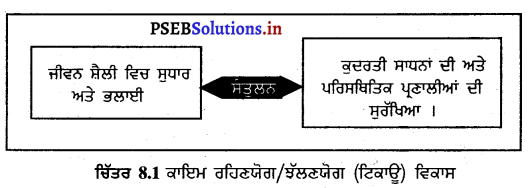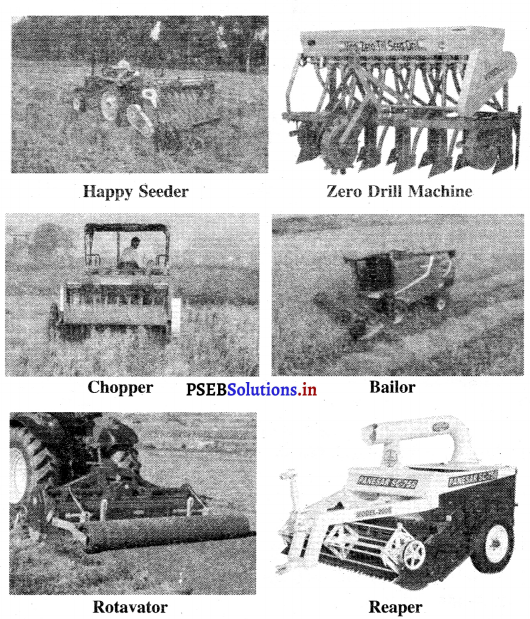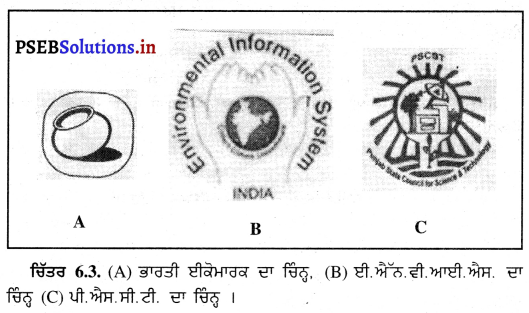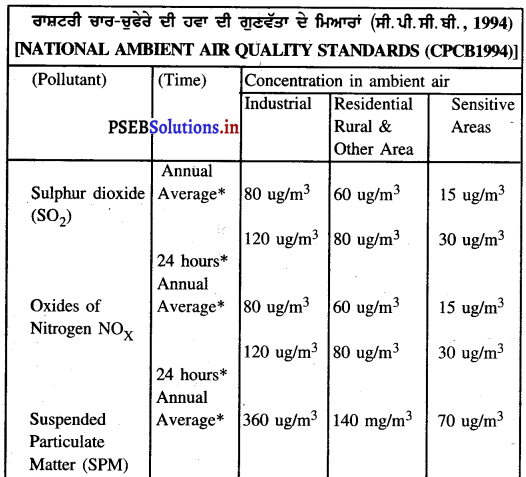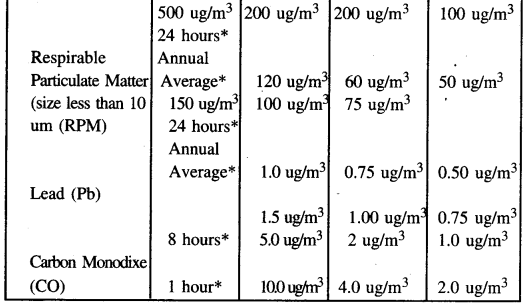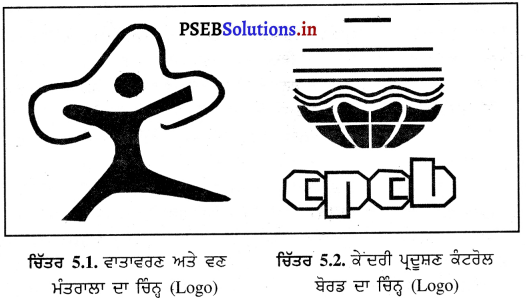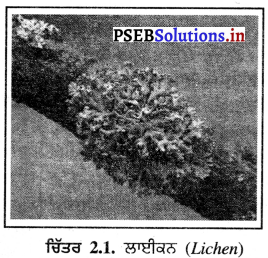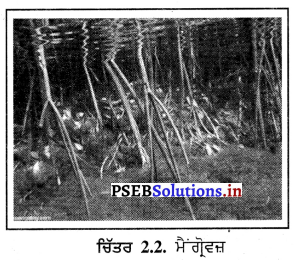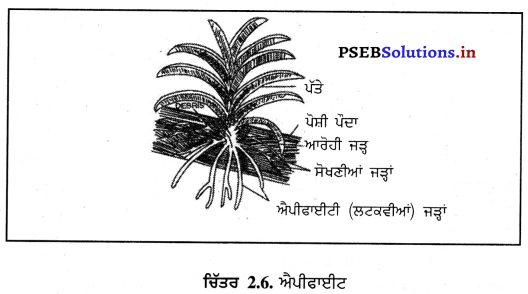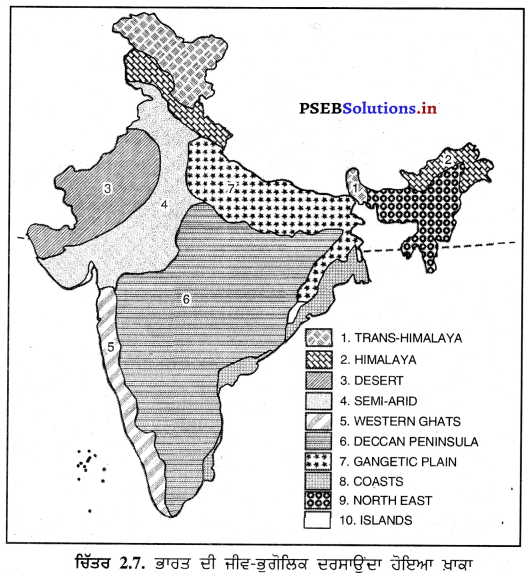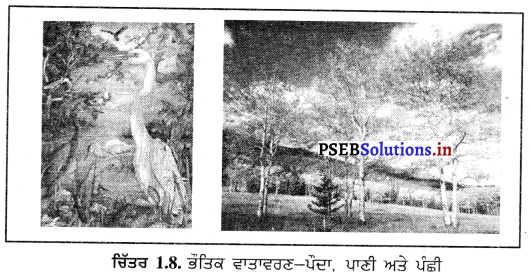Punjab State Board PSEB 12th Class Environmental Education Important Questions Chapter 12 ਕਾਇਮ ਰਹਿਣਯੋਗ / ਝੱਲਣਯੋਗ / ਟਿਕਾਊ ਖੇਤੀਬਾੜੀ (ਭਾਗ-2) Important Questions and Answers.
PSEB 12th Class Environmental Education Important Questions Chapter 12 ਕਾਇਮ ਰਹਿਣਯੋਗ / ਝੱਲਣਯੋਗ / ਟਿਕਾਊ ਖੇਤੀਬਾੜੀ (ਭਾਗ-2)
ਬਹੁਤ ਛੋਟੇ ਉੱਤਰਾਂ ਵਾਲੇ ਪ੍ਰਸ਼ਨ (Very Short Answer Type Questions)
ਪ੍ਰਸ਼ਨ 1.
ਸਿੰਚਾਈ (Irrigation) ਕੀ ਹੈ ?
ਜਾਂ
ਸਿੰਚਾਈ ਸ਼ਬਦ ਤੋਂ ਤੁਸੀਂ ਕੀ ਸਮਝਦੇ ਹੋ ?
ਉੱਤਰ-
ਸਿੰਚਾਈ ਜਾਂ ਸਿੰਜਣਾ (Irrigation) – ਉੱਗਦੀ ਹੋਈ ਫ਼ਸਲ ਦੀ ਸਹਾਇਤਾ ਲਈ ਬਨਾਉਟੀ ਢੰਗ-ਤਰੀਕੇ ਨਾਲ ਖੇਤ ਨੂੰ ਪਾਣੀ ਲਾਉਣ ਨੂੰ ਸਿੰਚਾਈ ਕਰਨਾ ਜਾਂ ਸਿੰਜਣਾ ਕਹਿੰਦੇ ਹਨ ।
ਪ੍ਰਸ਼ਨ 2.
ਸਿੰਚਾਈ ਕਰਨ ਦੇ ਕੀ ਲਾਭ ਹਨ ?
ਉੱਤਰ-
ਘੱਟ ਬਾਰਸ਼ਾਂ ਹੋਣ ਦੇ ਕਾਰਨ ਪੈਦਾ ਹੋਈ ਪਾਣੀ ਦੀ ਸਮੱਸਿਆ ਨੂੰ ਸਿੰਚਾਈ ਨਾ ਕੇਵਲ ਹੱਲ ਹੀ ਕਰਦੀ ਹੈ, ਸਗੋਂ ਭੂਮੀ ਵਿਚਲੇ ਪਾਣੀ ਨੂੰ ਕਾਇਮ ਰੱਖਦਿਆਂ ਹੋਇਆਂ ਉਤਪਾਦਕਤਾ ਵਿਚ ਵਾਧਾ ਵੀ ਕਰਦੀ ਹੈ ।
![]()
ਪ੍ਰਸ਼ਨ 3.
ਸਿੰਚਾਈ ਕਰਨ ਦੇ ਵਾਸਤੇ ਕਿਹੜੇ ਜਲ-ਸਰੋਤਾਂ ਦੀ ਵਰਤੋਂ ਕੀਤੀ ਜਾਂਦੀ ਹੈ ?
ਉੱਤਰ-
- ਸਈ ਪਾਣੀ (Surface water)
- ਧਰਤੀ ਹੇਠਲਾ ਪਾਣੀ (Under ground water)
ਪ੍ਰਸ਼ਨ 4.
ਸਿੰਚਾਈ ਕਿਹੜੇ-ਕਿਹੜੇ ਕਾਰਕਾਂ (Factors) ਉੱਪਰ ਨਿਰਭਰ ਕਰਦੀ ਹੈ ?
ਉੱਤਰ-
- ਫਸਲ ਦੀ ਕਿਸਮ,
- ਭੂਮੀ ਦੀ ਕਿਸਮ ਉੱਤੇ ਸਿੰਚਾਈ ਨਿਰਭਰ ਕਰਦੀ ਹੈ ।
ਪ੍ਰਸ਼ਨ 5.
ਮੀਂਹ ਪੈਣ ਨੂੰ ਛੱਡ ਕੇ ਸਿੰਚਾਈ ਦੇ ਕੋਈ ਚਾਰ ਸੋਤਾਂ ਬਾਰੇ ਦੱਸੋ ।
ਉੱਤਰ-
- ਖੂਹ,
- ਤਾਲਾਬ,
- ਨਹਿਰਾਂ,
- ਦਰਿਆ ।
ਪ੍ਰਸ਼ਨ 6.
ਸਿੰਚਾਈ ਪ੍ਰਣਾਲੀ ਦੀਆਂ ਕੋਈ ਦੋ ਕਿਸਮਾਂ ਦੱਸੋ ।
ਉੱਤਰ-
- ਸਿਆੜ/ਖਾਲ ਸਿੰਚਾਈ (Furrow Irrigation)
- ਫੁਹਾਰਾ ਸਿੰਚਾਈ ।
ਪ੍ਰਸ਼ਨ 7.
ਸਿੰਚਾਈ ਦੀਆਂ ਦੋ-ਦੋ ਸਮੱਸਿਆਵਾਂ ਕਿਹੜੀਆਂ-ਕਿਹੜੀਆਂ ਹਨ ?
ਉੱਤਰ-
- ਸਈ ਪਾਣੀ ਦੇ ਹੱਕਾਂ ਦੀ ਪ੍ਰਾਪਤੀ ਲਈ ਸੰਘਰਸ਼ ਅਤੇ
- ਧਰਤੀ ਹੇਠਲੇ ਪਾਣੀ ਦਾ ਸਖਣਿਆਉਣਾ (Depletion) ।
ਪ੍ਰਸ਼ਨ 8.
ਤੁਪਕਾ ਸਿੰਚਾਈ (Trickle Irrigation) ਕੀ ਹੈ ?
ਉੱਤਰ-
ਸਿੰਚਾਈ ਕਰਨ ਦੀ ਉਹ ਪ੍ਰਣਾਲੀ, ਜਿਸ ਵਿਚ ਪੌਦਿਆਂ ਨੂੰ ਸਿੰਜਣ ਦੇ ਲਈ ਪਾਣੀ ਕਤਰਿਆਂ (Drops) (ਤੁਪਕਿਆਂ) ਦੀ ਸ਼ਕਲ ਵਿੱਚ ਜੜ੍ਹਾਂ ਦੇ ਨਜ਼ਦੀਕ ਮੁਹੱਈਆ ਕੀਤਾ ਜਾਂਦਾ ਹੈ ।
![]()
ਪ੍ਰਸ਼ਨ 9.
ਭਾਰਤ ਵਿਚ ਸਿੰਚਾਈ ਕਰਨ ਦੀਆਂ ਕਿਹੜੀਆਂ-ਕਿਹੜੀਆਂ ਪ੍ਰਣਾਲੀਆਂ ਨੂੰ ਅਪਣਾਇਆ ਜਾਂਦਾ ਹੈ ?
ਉੱਤਰ-
(ੳ) ਨਹਿਰੀ ਪ੍ਰਣਾਲੀ,
(ਅ) ਤਾਲਾਬ,
(ੲ) ਖੂਹ,
(ਸ) ਦਰਿਆ ਘਾਟੀ ਪ੍ਰਣਾਲੀ (River Valley System),
(ਹ) ਦਰਿਆ ਤੋਂ ਪਾਣੀ ਚੁੱਕ ਪ੍ਰਣਾਲੀ (River Lift System) ।
ਪ੍ਰਸ਼ਨ 10.
ਰੂੜੀ ਖਾਦਾਂ ਕੀ ਹਨ ?
ਉੱਤਰ-
ਬਨਸਪਤੀ ਦੀ ਰਹਿੰਦ-ਖੂੰਹਦ ਅਤੇ ਜਾਨਵਰਾਂ ਦੇ ਮਲ-ਮੂਤਰ ਉੱਪਰ ਸੂਖਮ ਜੀਵਾਂ ਦੁਆਰਾ ਵਿਘਟਨ ਕੀਤੇ ਜਾਣ ਉਪਰੰਤ ਪ੍ਰਾਪਤ ਹੋਣ ਵਾਲੇ ਪਦਾਰਥ ਨੂੰ ਰੂੜੀ ਦੀ ਖਾਦ ਜਾਂ ਡੰਗਰਾਂ ਦੇ ਵਾੜੇ ਦੀ ਖਾਦ (ਰੂੜੀ) ਆਖਦੇ ਹਨ ।
ਪ੍ਰਸ਼ਨ 11.
ਰੂੜੀ ਖਾਦ ਦੀ ਵਰਤੋਂ ਕਰਨ ਦੇ ਕੀ ਲਾਭ ਹਨ ?
ਉੱਤਰ-
ਰੂੜੀ ਖਾਦ ਤੋਂ ਤੋਂ ਮਿੱਟੀ ਨੂੰ ਮੱਲ੍ਹੜ ਪ੍ਰਾਪਤ ਹੋ ਜਾਂਦਾ ਹੈ । ਮੱਲ੍ਹੜ ਮਿੱਟੀ ਤੋਂ ਦੀ ਭੌਤਿਕ ਅਤੇ ਰਸਾਇਣਿਕ ਗਠਿਤਤਾ (Texture) ਵਿਚ ਸੁਧਾਰ ਲਿਆਉਂਦਾ ਹੈ ।
ਪ੍ਰਸ਼ਨ 12.
ਡੰਗਰਾਂ ਦੇ ਵਾੜੇ ਵਾਲੀ ਖਾਦ ਦਾ ਕੀ ਮਤਲਬ ਹੈ ?
ਉੱਤਰ-
ਬਨਸਪਤੀ ਦੀ ਰਹਿੰਦ-ਖੂੰਹਦ ਅਤੇ ਡੰਗਰਾਂ ਦੇ ਮਲ-ਮੂਤਰ ਦੇ ਮਿਸ਼ਰਣ ਤੋਂ ਜਿਹੜੀ ਖਾਦ ਤਿਆਰ ਹੁੰਦੀ ਹੈ, ਉਹ ਡੰਗਰਾਂ ਦੇ ਵਾੜੇ ਵਾਲੀ (Farm Yard Manure) ਅਖਵਾਉਂਦੀ ਹੈ ।
ਪ੍ਰਸ਼ਨ 13.
ਯਕੀਨੀ ਸਿੰਚਾਈ (Assured Irrigation) ਤੋਂ ਕੀ ਭਾਵ ਹੈ ?
ਉੱਤਰ-
ਜਿਸ ਇਲਾਕੇ ਵਿਚ ਸਾਲ ਭਰ ਦੇ ਲਈ ਸਿੰਚਾਈ ਕਰਨ ਦੇ ਵਾਸਤੇ ਪਾਣੀ ਉਪਲੱਬਧ ਹੋਵੇ, ਤਾਂ ਅਜਿਹੀ ਸਿੰਚਾਈ ਯਕੀਨੀ ਸਿੰਚਾਈ ਅਖਵਾਉਂਦੀ ਹੈ ।
ਪ੍ਰਸ਼ਨ 14.
ਹਾਨੀਕਾਰਕ ਜਾਂ ਨੁਕਸਾਨ ਕਰਨ ਵਾਲੇ ਜੀਵ (Pests) ਕੀ ਹਨ ? ‘
ਉੱਤਰ-
ਜਿਹੜੇ ਜੀਵ ਜਿਵੇਂ ਕਿ ਬੈਕਟੀਰੀਆ, ਉੱਲੀਆਂ, ਕੀਟ, ਚੂਹੇ ਅਤੇ ਮਾਈਟ (Mite) ਪੌਦਿਆਂ ਆਦਿ ਦਾ ਨੁਕਸਾਨ ਕਰਨ ਜਾਂ ਰੋਗ ਉਤਪੰਨ ਕਰਨ, ਉਨ੍ਹਾਂ ਜੀਵਾਂ ਨੂੰ ਹਾਨੀਕਾਰਕ ਜੀਵ ਪੈਂਸਟ (Pests) ਆਖਿਆ ਜਾਂਦਾ ਹੈ ।
![]()
ਪ੍ਰਸ਼ਨ 15.
ਕੋਈ ਦੋ ਅਜਿਹੇ ਫਰਟੇਲਾਈਜ਼ਰਜ਼ ਦੇ ਨਾਮ ਦੱਸੋ ਜਿਨ੍ਹਾਂ ਵਿਚ ਨਾਈਟ੍ਰੋਜਨ, ਫਾਸਫੇਟ ਅਤੇ ਪੋਟਾਸ਼ੀਅਮ (NPK) ਹੁੰਦੇ ਹਨ ।
ਉੱਤਰ-
ਨਾਈਟ੍ਰੋਫਾਸਫੇਟ (Nitrophosphate) ਅਤੇ ਪੋਟਾਸ਼ੀਅਮ ਸਲਫੇਟ (Potassium Sulphate)।
ਪ੍ਰਸ਼ਨ 16.
ਪੌਦਿਆਂ ਦੀਆਂ ਕੋਈ ਦੋ ਬੀਮਾਰੀਆਂ ਦੇ ਨਾਮ ਦੱਸੋ । (P.S.E.B. 2011)
ਉੱਤਰ-
ਆਲੂ ਦਾ ਪਛੇਤਾ ਝੁਲਸ ਰੋਗ (Late Blight of Potato) ਅਤੇ ਚੌਲਾਂ ਦਾ ਬਲਾਸਟ ਰੋਗ (Blast of Rice), ਚੌਲਾਂ ਦਾ ਭੁਰਾ ਧੱਬਾ ਰੋਗ (Brown spot of rice) ।
ਪ੍ਰਸ਼ਨ 17.
ਭਾਰਤ ਵਿਚ ਚੌਲਾਂ ਦੀਆਂ ਕੋਈ ਦੋ ਬਿਮਾਰੀਆਂ ਦੇ ਨਾਮ ਦੱਸੋ ।
ਉੱਤਰ-
- ਚੌਲਾਂ ਦਾ ਬਲਾਸਟ ਰੋਗ ।
- ਚੌਲਾਂ ਦੇ ਭੂਰੇ ਧੱਬੇ ।
ਪ੍ਰਸ਼ਨ 18.
ਜੈਵਿਕ ਵਧਾਅ ਜਾਂ ਜੈਵਿਕ ਵਿਸ਼ਾਲੀਕਰਨ (Biomagnification) ਕੀ ਹੈ ?
ਉੱਤਰ-
ਭੋਜਨ ਲੜੀ ਨਾਲ ਸੰਬੰਧਿਤ ਉੱਚ-ਕੋਟੀ ਦੇ ਖਪਤਕਾਰਾਂ ਦੇ ਸਰੀਰ ਅੰਦਰ ਜ਼ਹਿਰੀਲੇ ਪਦਾਰਥਾਂ ਦੀ ਸੰਘਣਤਾ ਦਾ ਵੱਧ ਜਾਣਾ, ਜੈਵਿਕ ਵਧਾਅ ਅਖਵਾਉਂਦਾ ਹੈ ।
ਪ੍ਰਸ਼ਨ 19.
ਕੀਟਨਾਸ਼ਕ (Insecticides) ਕੀ ਹਨ ?
ਉੱਤਰ-
ਜਿਹੜੇ ਰਸਾਇਣ ਕੀਟਾਂ ਦਾ ਵਿਨਾਸ਼ ਕਰਨ, ਉਨ੍ਹਾਂ ਰਸਾਇਣਾਂ ਨੂੰ ਕੀਟਨਾਸ਼ਕ ਕਹਿੰਦੇ ਹਨ ।
ਪ੍ਰਸ਼ਨ 20.
ਈ. ਡੀ. ਬੀ. (EDB) ਦਾ ਵਿਸਥਾਰ ਕਰੋ ।
ਉੱਤਰ-
ਈ. ਡੀ.ਬੀ. (EDB) = ਐਥਲੀਨ ਡਾਈਬੋਮਾਈਡ (Ethylene dibromide) ।
![]()
ਪ੍ਰਸ਼ਨ 21.
ਮਿੱਟੀ ਖੁਰਣ ਦੇ ਦੋ ਭੈੜੇ ਪ੍ਰਭਾਵਾਂ ਬਾਰੇ ਲਿਖੋ ।
ਉੱਤਰ-
ਮਿੱਟੀ ਦੇ ਖੁਰਣ ਦੇ ਕਾਰਨ ਇਸ ਵਿਚਲੇ ਪੌਸ਼ਟਿਕ ਪਦਾਰਥ ਨਿਕਲ ਜਾਂਦੇ ਹਨ ।
ਮਿੱਟੀ ਦੀ ਮੋਟਾਈ ਘੱਟ ਜਾਣ ਦੇ ਫਲਸਰੂਪ, ਮਿੱਟੀ ਦੀ ਪਾਣੀ ਨੂੰ ਸੰਭਾਲਣ ਦੀ ਸਮਰੱਥਾ ਘੱਟ ਜਾਂਦੀ ਹੈ ।
ਪ੍ਰਸ਼ਨ 22.
ਦੋ ਤਰ੍ਹਾਂ ਦੇ ਫਰਟੇਲਾਈਜ਼ਰਜ਼ ਦੇ ਨਾਮ ਦੱਸੋ ।
ਉੱਤਰ-
- ਖਣਿਜੀ ਜਾਂ ਰਸਾਇਣਿਕ ਫਰਟੇਲਾਈਜ਼ਰ,
- ਜੈਵਿਕ ਫਰਟੇਲਾਈਜ਼ਰ (Biological fertilizer) ।
ਪ੍ਰਸ਼ਨ 23.
ਤਿੰਨ ਪ੍ਰਕਾਰ ਦੇ ਰਸਾਇਣਿਕ ਫਰਟੇਲਾਈਜ਼ਰਜ਼ ਦੇ ਨਾਮ ਦੱਸੋ ।
ਉੱਤਰ-
- ਨਾਈਟ੍ਰੋਜਨੀ ਖਾਦ (Nitrogenous fertilizer)
- ਫਾਸਫੇਟੀ ਖਾਦ (Phosphatic fertilizers)
- ਪੋਟਾਸ਼ੀਅਮ ਫਰਟੇਲਾਈਜ਼ਰ (Potassium fertilizer) ।
ਪ੍ਰਸ਼ਨ 24.
ਮੁਰਝਾਉਣਾ (wilt) ਅਤੇ ਕੈਂਕਰ (Canker) ਨੂੰ ਪਰਿਭਾਸ਼ਿਤ ਕਰੋ ।
ਉੱਤਰ-
ਕਮਲਾਉਣਾ (Wilt) – ਪੌਦੇ ਦੇ ਫੈਲਾਉ ਵਿਚ ਕਮੀ ਆ ਜਾਣ ਦੇ ਕਾਰਨ ਸਮੁੱਚੇ ਪੌਦੇ ਦਾ ਨੀਵਾਂ ਹੋ ਜਾਣਾ, ਮੁਰਝਾਉਣਾ ਅਖਵਾਉਂਦਾ ਹੈ ।
ਕੈਂਕਰ (Canker) – ਟਿਸ਼ੂਆਂ ਦੇ ਸਥਾਨਕ ਗਲਣ-ਸੜਣ ਦੇ ਕਾਰਨ ਕਈ ਵਾਰੀ ਖੁੱਲ੍ਹੇ ਜ਼ਖ਼ਮ (Open wounds), ਜਿਹੜੇ ਕਿ ਜੀਵਿਤ ਟਿਸ਼ੂਆਂ ਦੁਆਰਾ ਘਿਰੇ ਹੋਏ ਹੋਣ, ਪੈਦਾ ਹੋ . ਜਾਂਦੇ ਹਨ । ਅਜਿਹੀਆਂ ਨਿਸ਼ਾਨੀਆਂ (Symptoms) ਨੂੰ ਕੈਂਕਰ ਆਖਿਆ ਜਾਂਦਾ ਹੈ ।
ਪ੍ਰਸ਼ਨ 25.
ਆਲੂ ਦੇ ਪਛੇਤੇ ਝੁਲਸ ਰੋਗ ਦੇ ਰੋਗਜਨਕ ਦਾ ਨਾਮ ਦੱਸੋ ।
ਉੱਤਰ-
ਆਲੂ ਦੇ ਪਛੇਤੇ ਝੁਲਸ ਰੋਗ ਦੇ ਰੋਗਜਨਕ ਦਾ ਨਾਮ ਫਾਈਟੌਪਥੋਰਾ ਇੰਟੈਂਸਟੈਂਸ (Phytophthora infestans) ਹੈ ।
ਪ੍ਰਸ਼ਨ 26.
ਪੌਦਿਆਂ ਦੀਆਂ ਬੀਮਾਰੀਆਂ ਦਾ ਪੱਤਣ ਰੋਕ ਉਪਾਅ (Quarantine measures) ਕੀ ਹੈ ?
ਉੱਤਰ-
ਰੋਗ ਪ੍ਰਭਾਵਿਤ ਇਲਾਕਿਆਂ ਤੋਂ ਰੋਗ ਰਹਿਤ ਇਲਾਕਿਆਂ ਵਿਚ ਰੋਗ ਜੇਨਕਾਂ ਦੇ ਦਾਖ਼ਲੇ ਉੱਤੇ ਲਗਾਈ ਗਈ ਕਾਨੂੰਨੀ ਰੋਕ ਨੂੰ ਪੱਤਣ ਰੋਕ ਉਪਾਅ ਆਖਦੇ ਹਨ ।
![]()
ਪ੍ਰਸ਼ਨ 27.
ਪੌਦਿਆਂ ਦੇ ਵਾਧੇ ਉੱਪਰ ਨਮਕੀਨੀਕਰਨ (Salinity) ਦਾ ਕੀ ਅਸਰ ਪੈਂਦਾ ਹੈ ?
ਉੱਤਰ-
ਖਾਰੇਪਨ ਦੇ ਕਾਰਨ ਪੌਦਿਆਂ ਦਾ ਕੱਦ ਛੋਟਾ ਰਹਿ ਜਾਂਦਾ ਹੈ ਅਤੇ ਫ਼ਸਲ ਦਾ ਝਾੜ ਵੀ ਘੱਟ ਜਾਂਦਾ ਹੈ ।
ਪ੍ਰਸ਼ਨ 28.
ਰਸਾਇਣਿਕ ਨਦੀਨਨਾਸ਼ਕਾਂ ਦੀ ਵਰਤੋਂ ਦੇ ਕੀ ਨੁਕਸਾਨ ਹਨ ?
ਉੱਤਰ-
- ਨਦੀਨਨਾਸ਼ਕਾਂ ਦੀ ਅਢੁੱਕਵੀਂ ਵਰਤੋਂ ਪੌਦਿਆਂ ਨੂੰ ਨੁਕਸਾਨ ਪਹੁੰਚਾ ਸਕਦੀ ਹੈ ।
- ਨਦੀਨਨਾਸ਼ਕਾਂ ਦੀ ਵਰਤੋਂ ਕਰਨ ਦੇ ਫਲਸਰੂਪ ਨਦੀਨਨਾਸ਼ਕਾਂ ਦਾ ਵਿਰੋਧ ਕਰਨ ਵਾਲੀਆਂ ਕਿਸਮਾਂ ਪੈਦਾ ਹੋ ਸਕਦੀਆਂ ਹਨ ।
ਪ੍ਰਸ਼ਨ 29.
ਕੁੱਝ ਜ਼ਰੂਰੀ ਧੂਣੀ ਪਦਾਰਥਾਂ (Fumigants) ਦੇ ਨਾਮ ਦੱਸੋ ।
ਉੱਤਰ-
ਕੁੱਝ ਧੂਣੀ ਪਦਾਰਥ (Some Fumigants)-
- ਐੱਥਲੀਨ ਡਾਈਬੋਮਾਂਈਡ (Ethylene Dibromide, EDB)
- ਅਮੋਨੀਅਮ ਫਾਂਸਫਾਈਡ (Ammonium Phosphide) ਇਸ ਨੂੰ ਸਲਫਾਂਸ (Celphos) ਵੀ ਆਖਦੇ ਹਨ ।
- ਮੈਥਿਲਬੋਮਾਈਡ (Methyl bromide) (CH,Br) ।
ਪ੍ਰਸ਼ਨ 30.
ਕੁੰਗੀ (Rust) ਅਤੇ ਕਾਂਗਿਆਰੀ (Smut) ਦੀ ਪਰਿਭਾਸ਼ਾ ਲਿਖੋ ।
ਉੱਤਰ-
ਕੁੰਗੀ (Rust) – ਪੋਸ਼ੀ (Host) ਦੀ ਸੜਾ ‘ਤੇ ਧੂੜ ਦੀ ਸ਼ਕਲ ਵਿਚ ਦਿਸਣ ਵਾਲੇ ਅਤੇ ਥੋੜ੍ਹੀਆਂ ਥਾਂਵਾਂ ਤੇ ਪਾਏ ਜਾਣ ਵਾਲੇ ਪੀਲੇ, ਲਾਲ, ਭੂਰੇ ਜਾਂ ਕਾਲੇ ਰੰਗ ਵਾਲੇ ਧੱਬਿਆਂ ਵਾਲੀ ਬੀਮਾਰੀ ਨੂੰ ਕੁੰਗੀ ਆਖਦੇ ਹਨ ।
ਕਾਂਗਿਆਰੀ (Smut)-ਕਾਲੇ ਰੰਗ ਦੀਆਂ ਧੂੰਆਂਖ ਦੀਆਂ ਨਿਸ਼ਾਨੀਆਂ ਵਾਲਾ ਰੋਗ, ਜਿਸ ਵਿਚ ਰੋਗ ਫੈਲਾਉਣ ਵਾਲੇ ਬੀਜਾਣੁ (Spores) ਸਮੂਹਾਂ ਦੀ ਸ਼ਕਲ ਵਿਚ ਪੈਦਾ ਹੋਣ, ਉਸ ਰੋਗ ਨੂੰ ਕਾਂਗਿਆਰੀ ਆਖਦੇ ਹਨ । ਜਿਵੇਂ ਕਿ ਕਣਕ ਦਾ ਕਾਂਗਿਆਰੀ ਰੋਗ ।
ਪ੍ਰਸ਼ਨ 31.
ਸਕੈਬ (Scab) ਅਤੇ ਕੈਂਕਰ (Canker) ਰੋਗਾਂ ਦੀ ਇੱਕ-ਇੱਕ ਉਦਾਹਰਣ ਦਿਉ ।
ਉੱਤਰ-
ਸੇਬ (ਦਾ) ਸਕੈਬ (Apple Scab) ਅਤੇ ਸਿਟਰਸ ਕੈਂਕਰ (Citrus Canker) ।
ਪ੍ਰਸ਼ਨ 32.
ਡੀ. ਡੀ.ਟੀ. (DDT) ਦਾ ਵਿਸਥਾਰ ਕਰੋ ।
ਉੱਤਰ-
ਡੀ.ਡੀ.ਟੀ. (DDT) = Dichloro Diphenyl Trichloromethane.
![]()
ਪ੍ਰਸ਼ਨ 33.
ਰਸਾਇਣਿਕ ਖਾਦ ਦੀ ਵਰਤੋਂ ਦੇ ਦੋ ਪ੍ਰਭਾਵਾਂ ਬਾਰੇ ਦੱਸੋ ।
ਉੱਤਰ-
ਰਸਾਇਣਿਕ ਖਾਦ ਦੇ ਦੋ ਪ੍ਰਭਾਵ-
- ਧਰਤੀ ਹੇਠਲੇ ਪਾਣੀ ਦਾ ਪ੍ਰਦੂਸ਼ਣ
- ਸਤੱਈ ਪਾਣੀ ਦਾ ਪ੍ਰਦੂਸ਼ਣ ।
ਪ੍ਰਸ਼ਨ 34.
ਚਾਰ ਪੈਂਸਟੀਸਾਈਡਜ਼ ਦੀ ਸੂਚੀ ਦਿਉ ।
ਉੱਤਰ-
ਚਾਰ ਸਟੀਸਾਈਡਜ਼ ਦੀ ਸੂਚੀ-
- ਬੀ. ਐੱਚ. ਸੀ. (BAC),
- ਡੀ.ਡੀ.ਟੀ. (DDT),
- ਐੱਚ. ਸੀ. ਐੱਚ. (HCH),
- ਐਂਡੋਸਲਫਾਨ (Endosulphan) ।
ਪ੍ਰਸ਼ਨ 35.
ਰਸਾਇਣਿਕ ਖਾਦਾਂ ਅਤੇ ਪੈਸਟੀਸਾਈਡਜ਼ ਦੀ ਜ਼ਿਆਦਾ ਵਰਤੋਂ ਕਰਨ ਨਾਲ ਪੈਣ ਵਾਲੇ ਵਿਗਾੜਾਂ ਬਾਰੇ ਦੱਸੋ ।
ਉੱਤਰ-
ਰਸਾਇਣਿਕ ਖਾਦਾਂ ਅਤੇ ਜੀਵਨਾਸ਼ਕਾਂ ਦੀ ਜ਼ਿਆਦਾ ਵਰਤੋਂ ਕਰਨ ਦੇ ਵਿਗਾੜ ਹਨ-
- ਅੰਤਰ-ਰਿਸਾਵੀ ਗ੍ਰੰਥੀਆਂ (Endocrineglands) ਵਿਚ ਵਿਕਾਰ ।
- ਕੈਂਸਰ (Cancer) ।
- ਦਮਾ (Asthma) ।
- ਗੁਰਦਿਆਂ ਵਿਚ ਵਿਗਾੜ ।
ਪ੍ਰਸ਼ਨ 36.
ਕੀਟਨਾਸ਼ਕਾਂ ਦੇ ਜ਼ਹਿਰੀਲੇਪਨ ਕਾਰਨ ਹੋਣ ਵਾਲੇ ਕੁਝ ਰੋਗਾਂ ਦੇ ਨਾਂ ਲਿਖੋ ।
ਉੱਤਰ-
- ਕੈਂਸਰ,
- ਦਮਾ (Asthma),
- ਗੁਰਦੇ ਦੇ ਰੋਗ ।
ਛੋਟੇ ਉੱਤਰਾਂ ਵਾਲੇ ਪ੍ਰਸ਼ਨ (Short Answer Type Questions)
ਪ੍ਰਸ਼ਨ 1.
ਵਰਖਾ ਨੂੰ ਛੱਡ ਕੇ ਸਿੰਚਾਈ ਕਰਨ ਦੀਆਂ ਪ੍ਰਣਾਲੀਆਂ ਦਾ ਸੰਖੇਪ ਵਿਚ ਵਰਣਨ ਕਰੋ ।
ਉੱਤਰ-
ਵਰਖਾ ਨੂੰ ਛੱਡ ਕੇ ਭਾਰਤ ਵਿਚ ਵਰਤੇ ਜਾਂਦੇ ਸਿੰਚਾਈ ਕਰਨ ਦੇ ਤਰੀਕੇ ਹਨ-
- ਖੂਹ (Wells) – ਖੂਹ ਦੋ ਤਰ੍ਹਾਂ ਦੇ ਹਨ-
(i) ਪੁੱਟੇ ਹੋਏ ਖੂਹ (Dugwells) ਅਤੇ (ii) ਟਿਊਬਵੈੱਲ ਜਾਂ ਬੰਬੀਆਂ (Tubewells)। ਪੁੱਟੇ ਹੋਏ ਖੂਹਾਂ ਦੇ ਮੁਕਾਬਲੇ ਬੰਬੀਆਂ ਬਹੁਤ ਸਸਤੀਆਂ ਹਨ । ਖੂਹਾਂ ਜਾਂ ਬੰਬੀਆਂ ਦੇ ਰਾਹੀਂ ਜ਼ਮੀਨ ਵਿਚੋਂ ਪਾਣੀ ਨੂੰ ਕਈ ਤਰੀਕਿਆਂ ਨਾਲ ਚੁੱਕਿਆ ਜਾਂਦਾ ਹੈ । ਪਾਣੀ ਨੂੰ ਖਿੱਚਣ ਦੇ ਲਈ ਜਾਂ ਤਾਂ ਹੱਥਾਂ ਨਾਲ (Manually) ਜਾਂ ਬਿਜਲੀ ਦੇ ਪੰਪਾਂ ਦੀ ਸਹਾਇਤਾ ਨਾਲ ਕੱਢਿਆ ਜਾਂਦਾ ਹੈ । - ਤਾਲਾਬ (Tanks) – ਤਾਲਾਬ ਮੀਂਹ ਦੇ ਪਾਣੀ ਦੇ ਇਲਾਵਾ ਪਾਣੀ ਬੋਚ ਖੇਤਰਾਂ (Catchment Areas) ਤੋਂ ਵਹਿੰਦੇ ਪਾਣੀ ਨੂੰ ਇਕੱਠਾ ਕਰਨ ਵਾਲੇ ਛੋਟੇ-ਛੋਟੇ ਹੌਜ਼ ਹੁੰਦੇ ਹਨ । ਸਟੋਰ ਕੀਤੇ ਹੋਏ ਇਸ ਪਾਣੀ ਦੀ ਸਿੰਚਾਈ ਕਰਨ ਲਈ ਵਰਤੋਂ ਕੀਤੀ ਜਾਂਦੀ ਹੈ ।
- ਨਹਿਰਾਂ (Canals) – ਹਿਰਾਂ ਵੱਡੀ ਅਤੇ ਵਿਸ਼ਾਲ ਪੱਧਰ ਤੇ ਸਿੰਚਾਈ ਕਰਨ ਵਾਲੀਆਂ ਪ੍ਰਣਾਲੀਆਂ ਹਨ । ਨਹਿਰਾਂ ਤੋਂ ਨਿਕਲਣ ਵਾਲੀਆਂ ਸ਼ਾਖਾਵਾਂ ਨੂੰ ਸੂਏ (Branch Canals) ਅਤੇ ਸੂਇਆਂ ਤੋਂ ਨਿਕਲਣ ਵਾਲੀਆਂ ਸ਼ਾਖਾਵਾਂ ਨੂੰ ਖਾਲੇ ਜਾਂ ਖਾਲ ਆਖਦੇ ਹਨ । ਇਹ ਖਾਲਾਂ ਲਗਪਗ ਸਾਰੇ, ਖੇਤਾਂ ਤਕ ਪਾਣੀ ਪਹੁੰਚਾਉਂਦੀਆਂ ਹਨ ।
- ਦਰਿਆ (Rivers) – ਸਾਡੇ ਦੇਸ਼ ਵਿਚ ਦਰਿਆਈ ਸਿੰਚਾਈ ਦੇ ਕਈ ਪ੍ਰਾਜੈਂਕਟ ਕੰਮ ਕਰ ਰਹੇ ਹਨ । ਦਰਿਆਵਾਂ ਉੱਤੇ ਬੰਨ੍ਹ (Barages), ਡੈਮਾਂ ਅਤੇ ਮੋੜਾਂ (Bends) ਦਾ ਨਿਰਮਾਣ ਕਰਕੇ ਪਾਣੀ ਦੇ ਵਹਿਣ ਦਾ ਰੁਖ ਮੋੜਿਆ ਜਾਂਦਾ ਹੈ । ਇਨ੍ਹਾਂ ਬੰਨ੍ਹਾਂ ਅਤੇ ਡੈਮਾਂ ਆਦਿ ਤੇ ਸਲਾਇਸ ਵਾਲਵ (Slice valve) ਲਗਾ ਕੇ ਪਾਣੀ ਦੇ ਹੇਠਲੇ ਪਾਸੇ ਵਲ ਵੱਗਣ ਨੂੰ ਨਿਯੰਤਰਿਤ ਕੀਤਾ ਜਾਂਦਾ ਹੈ । ਇਹ ਵਾਲਵ ਉੱਪਰੋਂ ਆਉਣ ਵਾਲੇ ਪਾਣੀ ਦੇ ਵਹਾਉ ਨੂੰ ਵੀ ਕੰਟਰੋਲ ਕਰਦੇ ਹਨ ।
ਪ੍ਰਸ਼ਨ 2.
ਉਚਿਤ ਸਿੰਚਾਈ ਲਈ ਪਾਣੀ ਦੀਆਂ ਕੀ ਲੋੜਾਂ ਹਨ ? ਨੋਟ ਲਿਖੋ ।
ਉੱਤਰ-
ਚਿਤ ਸਿੰਚਾਈ ਲਈ ਪਾਣੀ ਦੀਆਂ ਲੋੜਾਂ-ਜੇਕਰ ਵੱਖ-ਵੱਖ ਫ਼ਸਲਾਂ ਨੂੰ ਠੀਕ ਸਮੇਂ ਸਿਰ, ਠੀਕ ਮਾਤਰਾ ਵਿਚ ਪਾਣੀ ਦਿੱਤਾ ਜਾਂਦਾ ਰਹੇ ਤਾਂ ਪਦਾਰਥਾਂ ਦੇ ਉਤਪਾਦਨ ਵਿਚ ਚੋਖਾ ਵਾਧਾ ਕੀਤਾ ਜਾ ਸਕਦਾ ਹੈ । ਸਿੰਚਾਈ ਲਈ ਵਰਤੇ ਜਾਂਦੇ ਪਾਣੀ ਤੋਂ ਹੇਠ ਲਿਖੇ ਲਾਭ ਹੋ ਸਕਦੇ ਹਨ-
- ਮਿੱਟੀ ਵਿੱਚ ਹਵਾ ਦਾ ਵਧੀਆ ਸੰਚਾਰਨ ।
- ਪੌਸ਼ਟਿਕ ਪਦਾਰਥਾਂ ਦੇ ਰਿਸਣ ਦੁਆਰਾ ਹੋਣ ਵਾਲੇ ਨੁਕਸਾਨ ਵਿਚ ਕਮੀ ।
- ਫ਼ਸਲਾਂ ਦੁਆਰਾ ਪਾਣੀ ਦੀ ਕੀਤੀ ਜਾਂਦੀ ਵਰਤੋਂ ਵਿਚ ਨਿਪੁੰਨਤਾ ।
ਪ੍ਰਸ਼ਨ 3.
ਸਿੰਚਾਈ ਕੀ ਹੈ ? ਸਿੰਚਾਈ ਦੀ ਮਹੱਤਤਾ ਦਾ ਵਰਣਨ ਕਰੋ ।
ਉੱਤਰ-
ਨਹਿਰਾਂ, ਪਾਣੀ ਦੇ ਹੌਜ਼ਾਂ (Water Reservoirs), ਖੂਹਾਂ, ਬੰਬੀਆਂ ਆਦਿ ਦੁਆਰਾ ਖੇਤਾਂ ਵਿਚ ਉੱਗ ਰਹੀਆਂ ਫ਼ਸਲਾਂ ਨੂੰ ਪਾਣੀ ਦੇਣ ਦੀ ਵਿਧੀ ਸਿੰਚਾਈ ਅਖਵਾਉਂਦੀ ਹੈ ।
ਸਿੰਚਾਈ ਦੀ ਮਹੱਤਤਾ (Importance of Irrigation)-
- ਜ਼ਰੂਰੀ ਤੱਤਾਂ ਦੀ ਸਪਲਾਈ (Supply of Essential Elements) – ਸਿੰਚਾਈ ਦੁਆਰਾ ਦਿੱਤੇ ਗਏ ਪਾਣੀ ਤੋਂ ਪੌਦਿਆਂ ਨੂੰ ਹਾਈਡ੍ਰੋਜਨ ਅਤੇ ਆਕਸੀਜਨ ਦੋ ਮਹੱਤਵਪੂਰਨ ਤੱਤ ਪ੍ਰਾਪਤ ਹੁੰਦੇ ਹਨ ।
- ਬੀਜਾਂ ਦਾ ਪੁੰਗਰਨਾ (Germination of Seeds) – ਸਿੰਚਾਈ ਕਾਰਨ ਖੇਤ ਦੀ ਮਿੱਟੀ ਵਿਚ ਮੌਜੂਦ ਸਿੱਲ੍ਹ ਨਮੀ) ਬੀਜਾਂ ਦੇ ਪੁੰਗਰਨ ਲਈ ਸਹਾਈ ਹੁੰਦੀ ਹੈ ।
- ਵਾਧਾ (Growth) – ਜ਼ਮੀਨ ਵਿਚ ਪਾਣੀ ਦੀ ਹੋਂਦ ਦੇ ਕਾਰਨ ਪੌਦਿਆਂ ਦੀਆਂ ਜੜ੍ਹਾਂ ਅਤੇ ਪੌਦੇ ਵੱਧਦੇ ਹਨ ।
- ਪੌਸ਼ਟਿਕ ਤੱਤਾਂ ਦਾ ਸੋਖਣ (Absorption of Nutrients) – ਸਿੰਜਣ ਸਮੇਂ ਖੇਤਾਂ ਨੂੰ ਦਿੱਤੇ ਗਏ ਪਾਣੀ ਵਿਚ ਘੁਲਣਸ਼ੀਲ ਪੌਸ਼ਟਿਕ ਪਦਾਰਥ ਘੁਲ ਕੇ ਘੋਲ ਬਣਾ ਦਿੰਦੇ ਹਨ ਅਤੇ ਪੌਦਿਆਂ ਦੀਆਂ ਜੜਾਂ ਇਨ੍ਹਾਂ ਘੋਲਾਂ ਨੂੰ ਆਸਾਨੀ ਨਾਲ ਸੋਖ ਲੈਂਦੀਆਂ ਹਨ ।
![]()
ਪ੍ਰਸ਼ਨ 4.
ਸਿੰਚਾਈ (Irrigation) ਨੂੰ ਨਿਯੰਤ੍ਰਿਤ ਕਰਨ ਵਾਲੇ ਕਾਰਕਾਂ ਦਾ ਵਰਣਨ ਕਰੋ ।
ਉੱਤਰ-
ਸਿੰਚਾਈ ਨੂੰ ਕੰਟਰੋਲ ਕਰਨ ਵਾਲੇ ਕਾਰਕ (Factors Controlling Irrigation)-
(i) ਫ਼ਸਲ ਦੀ ਕਿਸਮ (Nature of Crop) – ਹਰੇਕ ਫ਼ਸਲ ਨੂੰ ਉਸ ਦੇ ਵਾਧੇ ਦੇ ਪੜਾਅ ਤੇ ਪਾਣੀ ਦੀ ਨਿਸ਼ਚਿਤ ਮਾਤਰਾ ਦੀ ਲੋੜ ਹੁੰਦੀ ਹੈ । ਕੁੱਝ ਫ਼ਸਲਾਂ ਨੂੰ ਦੂਸਰੀਆਂ ਫ਼ਸਲਾਂ ਦੇ ਮੁਕਾਬਲੇ ਜ਼ਿਆਦਾ ਮਾਤਰਾ ਵਿਚ ਪਾਣੀ ਦੀ ਲੋੜ ਹੁੰਦੀ ਹੈ । ਇਸ ਸੰਬੰਧ ਵਿਚ ਕੁਝ ਉਦਾਹਰਨ ਇਹ ਹਨ-
(ਉ) ਝੋਨੇ (Paddy) ਦੀ ਫ਼ਸਲ ਨੂੰ ਪਾਣੀ ਦੀ ਜ਼ਰੂਰਤ ਬਹੁਤ ਜ਼ਿਆਦਾ ਹੁੰਦੀ ਹੈ । ਇਸ ਦੀ ਪਨੀਰੀ ਨੂੰ ਖੇਤਾਂ ਵਿਚ ਖੜ੍ਹੇ ਪਾਣੀ ਵਿਚ ਲਗਾਇਆ ਜਾਂਦਾ ਹੈ । ਫ਼ਸਲ ਨੂੰ ਪਾਣੀ ਦੀ ਲਗਾਤਾਰ ਪੂਰਤੀ ਕਰਦੇ ਰਹਿਣ ਦੀ ਲੋੜ ਹੁੰਦੀ ਹੈ ।
(ਅ) ਕਣਕ, ਮੱਕੀ, ਕਪਾਹ ਅਤੇ ਛੋਲਿਆਂ ਦੀਆਂ ਫ਼ਸਲਾਂ ਨੂੰ ਝੋਨੇ ਦੀ ਫ਼ਸਲੈ ਦੇ ਮੁਕਾਬਲੇ ਬਹੁਤ ਘੱਟ ਮਾਤਰਾ ਵਿਚ ਪਾਣੀ ਦੀ ਜ਼ਰੂਰਤ ਹੁੰਦੀ ਹੈ ।
(ii) ਮਿੱਟੀ ਦੀ ਕਿਸਮ (Nature of Soil) – ਰੇਤਲੀਆਂ ਜ਼ਮੀਨਾਂ ਨੂੰ ਜ਼ਿਆਦਾ ਪਾਣੀ ਦੀ ਲੋੜ ਹੁੰਦੀ ਹੈ । ਇਹ ਜ਼ਮੀਨਾਂ ਛਿਦਰੀਆਂ (Prous) ਹੋਣ ਕਾਰਨ ਇਨ੍ਹਾਂ ਅੰਦਰ ਪਾਣੀ ਜ਼ਿਆਦਾ ਦੇਰ ਤਕ ਨਹੀਂ ਠਹਿਰਦਾ । ਇਸ ਕਰਕੇ ਰੇਤਲੀਆਂ ਜ਼ਮੀਨਾਂ ਨੂੰ ਅਕਸਰ ਜਲਦੀਜਲਦੀ ਪਾਣੀ ਦੇਣ ਦੀ ਜ਼ਰੂਰਤ ਪੈਂਦੀ ਹੈ । ਚੀਕਣੀ ਮਿੱਟੀ ਵਾਲੀਆਂ ਜ਼ਮੀਨਾਂ ਆਪਣੇ ਅੰਦਰ ਸਮੋਏ ਹੋਏ ਪਾਣੀ ਨੂੰ ਲੰਮੇ ਸਮੇਂ ਤਕ ਰੋਕ ਕੇ ਰੱਖ ਸਕਦੀਆਂ ਹਨ ।
ਪ੍ਰਸ਼ਨ 5.
ਉੱਚਿਤ ਸਿੰਚਾਈ ਦੇ ਲਈ ਪਾਣੀ ਦੀ ਜ਼ਰੂਰਤ ਦਾ ਵਰਣਨ ਕਰੋ ।
ਉੱਤਰ-
ਉੱਚਿਤ ਸਿੰਚਾਈ ਦੇ ਲਈ ਪਾਣੀ ਦੀ ਜ਼ਰੂਰਤ (Water requirement for Proper Irrigation) – ਠੀਕ ਸਮੇਂ ਤੇ ਕੀਤੀ ਗਈ ਸਿੰਚਾਈ ਅਤੇ ਸਿੰਚਾਈ ਕਰਦੇ ਸਮੇਂ ਪਾਣੀ ਦੀ ਠੀਕ ਮਾਤਰਾ ਵਿਚ ਵਰਤੋਂ ਕਰਦਿਆਂ ਹੋਇਆਂ ਅਸੀਂ ਉਪਜ ਵਧੇਰੇ ਮਾਤਰਾ ਵਿਚ ਪ੍ਰਾਪਤ ਕਰ ਸਕਦੇ ਹਾਂ । ਵੱਖ-ਵੱਖ ਫ਼ਸਲਾਂ ਦੀ ਸਿੰਚਾਈ ਕਰਨ ਸਮੇਂ ਲੋੜੀਂਦੀ ਮਾਤਰਾ ਵਿਚ ਵਰਤੇ ਜਾਂਦੇ ਪਾਣੀ ਤੋਂ ਹੇਠ ਲਿਖੇ ਲਾਭ ਹੁੰਦੇ ਹਨ-
- ਪੌਦਿਆਂ ਦੁਆਰਾ ਪਾਣੀ ਦੇ ਵਰਤਣ ਵਿਚ ਨਿਪੁੰਨਤਾਂ ।
- ਖੁਰਣ (Leaching) ਦੁਆਰਾ ਖਣਿਜ ਤੱਤਾਂ ਦੀ ਹਾਨੀ ਨੂੰ ਘੱਟ ਕਰਨਾ ।
- ਤੋਂ ਵਿਚ ਹਵਾ ਦੀ ਵਧੀਆ ਆਵਾਜਾਈ ।
ਪ੍ਰਸ਼ਨ 6.
ਰਸਾਇਣਿਕ ਖਾਦਾਂ (Chemical Fertilizers) ਦੇ ਕੀ ਮਾੜੇ ਪ੍ਰਭਾਵ ਹਨ ?
ਉੱਤਰ-
ਰਸਾਇਣਿਕ ਖਾਦਾਂ ਦੇ ਮਾੜੇ ਪ੍ਰਭਾਵ-
- ਇਹ ਬਹੁਤ ਮਹਿੰਗੇ ਹਨ ।
- ਇਨ੍ਹਾਂ (ਖਾਦਾਂ) ਦਾ ਨਿਰਮਾਣ ਘੱਟ ਰਹੀ ਊਰਜਾ ਜਿਵੇਂ ਕਿ ਪੈਟਰੋਲੀਅਮ ਅਤੇ ਕੋਲਾ ਆਦਿ ਦੇ ਸਰੋਤਾਂ ਦੀ ਉਪਲੱਬਧੀ ਉੱਤੇ ਨਿਰਭਰ ਕਰਦਾ ਹੈ ।
- ਇਹ ਖਾਦਾਂ ਪਾਣੀ ਦੇ ਸਰੋਤਾਂ ਅਤੇ ਮਿੱਟੀ ਵਿਚ ਪ੍ਰਦੂਸ਼ਣ ਪੈਦਾ ਕਰਦੀਆਂ ਹਨ ।
- ਫਰਟੇਲਾਈਜ਼ਰਜ਼ ਦੀ ਲਗਾਤਾਰ ਕੀਤੀ ਜਾਂਦੀ ਵਰਤੋਂ ਦੇ ਫਲਸਰੂਪ ਮਿੱਟੀ ਦੇ ਰਸਾਇਣਿਕ ਸੁਭਾਅ ਵਿਚ ਤਬਦੀਲੀ ਆ ਜਾਂਦੀ ਹੈ, ਜਿਸ ਕਾਰਨ ਤੋਂ ਜਾਂ ਤਾਂ ਖਾਰੀ (Alkaline) ਬਣ ਜਾਂਦੀ ਹੈ ਜਾਂ ਇਹ ਤੇਜ਼ਾਬੀ (Acidic) ਹੋ ਜਾਂਦੀ ਹੈ ।
- ਇਨ੍ਹਾਂ ਖਾਦਾਂ ਦੀ ਤਿਆਰੀ ਸਮੇਂ ਪ੍ਰਦੂਸ਼ਣ ਫੈਲਦਾ ਹੈ ।
- ਖੇਤਾਂ ਵਿਚੋਂ ਪਾਣੀ ਦੇ ਰੁੜ੍ਹਣ ਨਾਲ ਇਹ ਜ਼ਾਇਆ ਹੋ ਜਾਂਦੀਆਂ ਹਨ ।
ਪ੍ਰਸ਼ਨ 7.
ਦੇਸੀ ਖਾਦ/ਰੂੜੀ ਦੀ ਖਾਦ (Manure) ਦੇ ਕੀ ਗੁਣ ਹਨ ?
ਉੱਤਰ-
- ਰੂੜੀ ਖਾਦਾਂ ਕੁਦਰਤੀ ਕਾਰਬਨੀ ਪਦਾਰਥ ਹਨ ਜਿਨ੍ਹਾਂ ਦੀ ਖੇਤਾਂ ਵਿਚ ਵਰਤੋਂ ਕਰਨ ਦੇ ਨਾਲ ਫ਼ਸਲਾਂ ਦੀ ਉਤਪਾਦਕਤਾ ਵਿਚ ਵਾਧਾ ਹੋ ਜਾਂਦਾ ਹੈ । ਇਹ ਖਾਦਾਂ ਕਾਰਬਨੀ ਪਦਾਰਥਾਂ ਦੇ ਵਿਘਟਨ ਕਾਰਨ ਬਣਦੀਆਂ ਹਨ ।
- ਰੂੜੀ ਦੀ ਖਾਦ ਤੋਂ ਦੀ ਭੌਤਿਕ ਹਾਲਤ ਵਿਚ ਸੁਧਾਰ ਪੈਦਾ ਕਰਦੀ ਹੈ ਅਤੇ ਪੌਦਿਆਂ ਨੂੰ ਲੋੜ ਵੇਲੇ ਤਕਰੀਬਨ ਸਾਰੇ ਪੌਸ਼ਟਿਕ ਪਦਾਰਥਾਂ ਦੀ ਪੂਰਤੀ ਕਰਦੀ ਹੈ ।
ਪ੍ਰਸ਼ਨ 8.
ਕੰਪੋਸਟ (Compost) ਤਿਆਰ ਕਰਨ ਦੇ ਤਰੀਕਿਆਂ ਬਾਰੇ ਲਿਖੋ ।
ਜਾਂ
ਬਨਸਪਤੀ ਖਾਦ ਕਿਵੇਂ ਤਿਆਰ ਕੀਤੀ ਜਾਂਦੀ ਹੈ ? ਵਿਸਥਾਰ ਸਹਿਤ ਵਰਣਨ ਕਰੋ ।
ਉੱਤਰ-
ਕੰਪੋਸਟ ਤਿਆਰ ਕਰਨ ਦੇ ਤਰੀਕੇ-
- ਕੰਪੋਸਟ ਤਿਆਰ ਕਰਨ ਦੇ ਲਈ 4-5 ਮੀਟਰ ਲੰਮੀ, 1.5 ਤੋਂ 1.8 ਮੀਟਰ ਚੌੜੀ ਅਤੇ ਅੰਦਰੋਂ 1.0-1.8 ਮੀਟਰ ਡੂੰਘੀ ਖਾਈ (Trench) ਪੁੱਟੀ ਜਾਂਦੀ ਹੈ ।
- ਇਸ ਖਾਈ ਵਿਚ ਚੰਗੀ ਤਰ੍ਹਾਂ ਮਿਲਾਇਆ ਗਿਆ ਰਹਿੰਦ-ਖੂੰਹਦ ਜਿਸ ਦੀ ਮੋਟਾਈ 30 ਸੈਂਟੀਮੀਟਰ ਹੁੰਦੀ ਹੈ, ਪਾ ਕੇ ਚੰਗੀ ਤਰ੍ਹਾਂ ਵਿਛਾ ਦਿੱਤਾ ਜਾਂਦਾ ਹੈ ।
- ਇਸ ਤਹਿ ‘ਤੇ ਗੋਬਰ ਤੋਂ ਤਿਆਰ ਕੀਤੀ ਗਈ ਸਲੱਰੀ (Slurry) ਦਾ ਛਿੜਕਾਅ ਕੀਤਾ ਜਾਂਦਾ ਹੈ ।
- ਰਲੀ ਹੋਈ ਰਹਿੰਦ-ਖੂੰਹਦ ਦੀ ਇਕ ਹੋਰ ਤਹਿ ਪਹਿਲੀ ਤਹਿ ਦੇ ਉੱਪਰ ਇਸ ਤਰ੍ਹਾਂ ਵਿਛਾਈ ਜਾਂਦੀ ਹੈ ਜਿਸ ਦੀ ਕੁੱਲ ਉੱਚਾਈ (ਸਮੇਤ ਪਹਿਲੀ ਪਰਤ ਦੀ ਉੱਚਾਈ ਦੇ 50-60 ਸੈਂਟੀਮੀਟਰ ਤਕ ਹੋ ਜਾਣੀ ਚਾਹੀਦੀ ਹੈ ।
- ਇਨ੍ਹਾਂ ਦੋਵਾਂ ਪਰਤਾਂ ਦਾ ਸਿਖਰ ਮਿੱਟੀ ਦੀ ਇਕ ਮਹੀਨ ਪਰਤ ਨਾਲ ਢੱਕ ਦਿੱਤਾ ਜਾਂਦਾ ਹੈ ।
- ਤਿੰਨ ਮਹੀਨਿਆਂ ਦੇ ਬਾਅਦ ਇਸ ਪਦਾਰਥ ਨੂੰ ਖਾਈ ਵਿਚੋਂ ਕੱਢ ਕੇ ਇਸ ਵਿਚ ਪਾਣੀ ਮਿਲਾ ਕੇ ਮਿੱਟੀ ਨਾਲ ਢੱਕ ਦਿੱਤਾ ਜਾਂਦਾ ਹੈ ।
- ਇਕ-ਦੋ ਮਹੀਨਿਆਂ ਦੇ ਅੰਤਰ ਕਾਲ ਦੇ ਬਾਅਦ ਇਹ ਕੰਪੋਸਟ ਵਰਤੋਂ ਦੇ ਕਾਬਿਲ ਹੋ ਜਾਂਦੀ ਹੈ ।
ਪ੍ਰਸ਼ਨ 9.
ਜਟਿਲ ਫਰਟੇਲਾਈਜ਼ਰਜ਼ (Complex Fertilizers) ਕੀ ਹਨ ?
ਉੱਤਰ-
ਜਿਸ ਖਾਦ ਵਿਚ ਦੋ ਜਾਂ ਦੋ ਤੋਂ ਵੱਧ ਪੌਸ਼ਟਿਕ ਪਦਾਰਥ ਮੌਜੂਦ ਹੋਣ, ਉਹ ਜਟਿਲ ਖਾਦ ਅਖਵਾਉਂਦੀ ਹੈ; ਜਿਵੇਂ ਕਿ N, P2O5 ਅਤੇ K2O ।
ਜਟਿਲ ਖਾਦਾਂ ਦੀਆਂ ਉਦਾਹਰਣਾਂ (Examples of Complex Fertilizers-
ਨਾਈਟ੍ਰੋਫਾਸਫੇਟ (Nitrophosphate), ਅਮੋਨੀਅਮ ਫਾਸਫੇਟ (Ammonium Phosphate) ਅਤੇ ਯੂਰੀਆ ਅਮੋਨੀਆ ਫਾਸਫੇਟ (Urea-Ammonia Phosphate) ।
ਜਿਹਨਾਂ ਖਾਦਾਂ ਵਿਚ ਨਾਈਟ੍ਰੋਜਨ, ਫਾਸਫੋਰਸ ਅਤੇ ਪੋਟਾਸ਼ੀਅਮ ਮੌਜੂਦ ਹੋਣ, ਉਨ੍ਹਾਂ ਖਾਦਾਂ ਨੂੰ ਸੰਪੂਰਨ ਖਾਦਾਂ ਜਾਂ ਮੁਕੰਮਲ ਖਾਦਾਂ (Complete Fertilizers) ਆਖਦੇ ਹਨ ।
![]()
ਪ੍ਰਸ਼ਨ 10.
ਰੂੜੀ ਦੀ ਖਾਦ (Manure) ਅਤੇ ਜੈਵ ਖਾਦ (Bio-fertilizers) ਵਿਚ ਅੰਤਰ ਦੱਸੋ ।
ਉੱਤਰ-
ਰੂੜੀ ਦੀ ਖਾਦ ਅਤੇ ਜੈਵ ਖਾਦ ਵਿਚ ਅੰਤਰ-
| ਲੜੀ ਨੰ: | ਲੱਛਣ | ਰੂੜੀ ਦੀ ਖਾਦ | ਜੈਵ-ਖਾਦ |
| 1. | ਪਰਿਭਾਸ਼ਾ (Definition) | ਆਮ ਤੌਰ ‘ਤੇ ਅਪ-ਘਟਿਤ ਰਹਿੰਦ-ਖੂੰਹਦ, ਜਿਹੜੀ ਕਿ ਭੋ ਵਿਚ ਰਲਾਈ ਜਾਣੀ ਹੈ । | ਜਿਹੜੇ ਜੀਵ ਆਪਣੀਆਂ ਕਿਰਿਆਵਾਂ ਦੁਆਰਾ ਤੋਂ ਵਿਚ ਪੌਸ਼ਟਿਕ ਪਦਾਰਥ ਰਲਾ ਕੇ, ਦੀ ਉਪਜਾਊ ਸ਼ਕਤੀ ਵਿਚ ਵਾਧਾ ਕਰਨ, ਉਹ ਜੈਵ ਖਾਦਾਂ ਵਿਚ ਸ਼ਾਮਿਲ ਹਨ । |
| 2. | ਭਰਪੂਰਤਾ (Enrichment) | ਇਹ ਖਾਦਾਂ ਤੋਂ ਦੀ ਹਵਾ ਦੀ ਆਵਾਜਾਈ ਸੰਚਾਰਨ ਨੂੰ ਠੀਕ ਕਰਨ ਦੇ ਨਾਲ-ਨਾਲ ਤੋਂ ਦੀ ਉਪਜਾਊ ਸ਼ਕਤੀ ਵਧਾਉਣ ਦੇ ਨਾਲ-ਨਾਲ ਪਾਣੀ ਜਕੜਨ ਦੀ ਸਮਰੱਥਾ ਵਿਚ ਵਾਧਾ ਕਰਦੀਆਂ ਹਨ । | ਇਹ ਖਾਦਾਂ ਤੋਂ ਦੇ ਰੂਪ ਨੂੰ ਕਾਇਮ ਰਹਿਣ ਜਾਂ ਨਾ ਕਾਇਮ ਰਹਿਣ ਵਿਚ ਹਿੱਸਾ ਪਾਉਂਦੀਆਂ ਹਨ । |
| 3. | ਪੌਸ਼ਟਿਕ ਪਦਾਰਥਾਂ ਦੀ ਸੰਖਿਆ (Number of Nutrients) | ਹਰੀ ਖਾਦ ਦੀ ਵਰਤੋਂ ਕਰਨ ਦੇ ਨਾਲ ਭੋਂ ਵਿਚ ਕਈ ਤਰ੍ਹਾਂ ਦੇ ਪੋਸ਼ਕ ਤੱਤ ਜਮਾਂ ਹੋ ਜਾਂਦੇ ਹਨ । ਰਸਾਇਣਿਕ ਖਾਦਾਂ ਪਾਉਣ ਦੀ ਲੋੜ ਪੈਂਦੀ ਹੈ । | ਜੈਵ ਖਾਦਾਂ ਤੋਂ ਬਹੁਤ ਹੀ ਘੱਟ ਪੌਸ਼ਕ ਤੱਤ ਉਪਲੱਬਧ ਹੁੰਦੇ ਹਨ । ਇਹ ਖਾਦ ਤੋਂ ਦੀ ਉਪਜਾਊ ਸ਼ਕਤੀ ਵਿਚ ਵਾਧਾ ਕਰਨ ਦੇ ਨਾਲ, ਰਸਾਇਣਿਕ ਖਾਦਾਂ ਦੀ ਮੰਗ ਨੂੰ ਘਟਾਉਂਦੇ ਹਨ । |
ਪ੍ਰਸ਼ਨ 11.
ਵੱਖ-ਵੱਖ ਤਰ੍ਹਾਂ ਦੇ ਜੀਵਨਾਸ਼ਕਾਂ (Pesticides) ਦੇ ਨਾਮ ਲਿਖੋ ।
ਉੱਤਰ-
ਪੈਸਟੀਸਾਈਡਜ਼ ਨੂੰ ਉਨ੍ਹਾਂ ਦੁਆਰਾ ਨਸ਼ਟ ਕੀਤੇ ਜਾਂਦੇ ਜੀਵਾਂ ਦੀਆਂ ਕਿਸਮਾਂ ਦੇ ਆਧਾਰ ‘ਤੇ ਹੇਠ ਲਿਖੀਆਂ ਕਿਸਮਾਂ ਵਿਚ ਵੰਡਿਆ ਗਿਆ ਹੈ –
(ੳ) ਉੱਲੀਨਾਸ਼ਕ (Fungicides) – ਉੱਲੀਆਂ ਨੂੰ ਮਾਰਦੇ ਹਨ ।
(ਅ) ਨਦੀਨਨਾਸ਼ਕ (Weedicides) – ਨਦੀਨਾਂ ਦਾ ਵਿਨਾਸ਼ ਕਰਦੇ ਹਨ ।
(ੲ) ਕੀਟਨਾਸ਼ਕ (Insecticides) – ਕੀਟਾਂ ਨੂੰ ਮਾਰਦੇ ਹਨ ।
(ਸ) ਨਿਮੈਟੀਸਾਈਡ
ਜਾਂ
ਗੋਲ ਕਿਰਮ ਨਾਸ਼ਕ ——————- ਗੋਲ ਕਿਰਮਾਂ (Nematodes) ਨੂੰ ਖ਼ਤਮ ਕਰਦੇ ਹਨ ।
(ਹ) ਕੁਤਰਾ ਕਰਨ ਵਾਲੇ —————– ਕੁਤਰਾ ਕਰਨ ਵਾਲੇ ਜੀਵਾਂ ਨੂੰ ਮਾਰਦੇ ਹਨ । ਜੀਵਾਂ ਦੇ ਨਾਸ਼ਕ (Rodenticides) ਜਿਵੇਂ ਕਿ ਚੂਹੇ ਆਦਿ ।
ਜੀਵਨਾਸ਼ਕਾਂ ਦੀ ਵਰਤੋਂ ਪਾਊਡਰ, ਘੋਲ, ਮਹੀਨ ਧੂੜ ਧੁੰਦ (Fine Mist) ਦੀ ਸ਼ਕਲ ਵਿਚ ਛਿੜਕਾਅ ਕੀਤਾ ਜਾਂਦਾ ਹੈ । ਇਹ ਰਸਾਇਣ ਪੌਦਿਆਂ, ਪ੍ਰਾਣੀਆਂ ਅਤੇ ਮਨੁੱਖਾਂ ‘ਤੇ ਅਸਰ ਕਰਨ ਵਾਲੇ ਖੁੱਲ੍ਹੇ ਸਪੈਕਟਰਮ (Broad Spectrum) ਵਾਲੇ ਪਦਾਰਥ ਹਨ । ਇਸ ਤਰ੍ਹਾਂ ਇਨ੍ਹਾਂ ਜੀਵਨਾਸ਼ਕਾਂ ਨੂੰ ਬਾਇਓਸਾਈਡਜ਼ ਭਾਵ ਜੀਵਨਾਸ਼ਕ (Biocides) ਵੀ ਆਖਿਆ ਜਾਂਦਾ ਹੈ ।
ਪ੍ਰਸ਼ਨ 12.
ਜੀਵਨਾਸ਼ਕਾਂ ਦੇ ਕਿਰਿਆ ਕਰਨ ਦਾ ਕੀ ਤਰੀਕਾ ਹੈ ?
ਉੱਤਰ-
ਪੈਸਟੀਸਾਈਡਜ਼ ਦੇ ਕਿਰਿਆ ਕਰਨ ਦਾ ਤਰੀਕਾ (Mode of action of Pesticides)
- ਕੀਟਨਾਸ਼ਕ ਸਜੀਵਾਂ ਦੀਆਂ ਢਾਹ-ਉਸਾਰੂ ਕਿਰਿਆਵਾਂ ਨੂੰ ਰੋਕਦੇ ਹਨ ।
- ਕੀਟਨਾਸ਼ਕ ਪ੍ਰਕਾਸ਼ ਸੰਸ਼ਲੇਸ਼ਣ ਦੇ ਦੂਜੇ ਪੜਾਅ (Photosynthesis-II) ਤੇ ਅਸਰ ਕਰਕੇ ਪ੍ਰਕਾਸ਼ ਸੰਸ਼ਲੇਸ਼ਣ ਪ੍ਰਤੀਕਿਰਿਆ ਦੀ ਦਰ ਨੂੰ ਘਟਾਉਂਦੇ ਹਨ । ਇਸ ਦੇ ਕਾਰਨ ਪੌਦਿਆਂ ਨੂੰ ਖ਼ੁਰਾਕ ਨਾ ਮਿਲਣ ਦੇ ਕਾਰਨ ਇਹ ਮਰ ਜਾਂਦੇ ਹਨ ।
- ਕੁੱਝ ਕੀਟਨਾਸ਼ਕ ਪੌਦਿਆਂ ਦੀਆਂ ਸੀਵ ਨਲੀਆਂ (Sieve Tubes) ਵਿਚ ਰੁਕਾਵਟਾਂ ਪਾ ਕੇ ਕਾਰਬਨੀ ਘੁਲਣਸ਼ੀਲ ਪਦਾਰਥਾਂ ਦੇ ਸਥਾਨਾਂਤਰਨ ਵਿਚ ਵਿਘਨ ਪਾਉਂਦੇ ਹਨ |
- ਕੁੱਝ ਕੀਟਨਾਸ਼ਕ ਜਾਨਵਰਾਂ ਕੀਟਾਂ ਆਦਿ ਦੀਆਂ ਨਾੜੀਆਂ ਰਾਹੀਂ ਗੁਜ਼ਰਨ ਵਾਲੀਆਂ ਉਤੇਜਨਾਵਾਂ ਵਿਚ ਰੁਕਾਵਟ ਪਾਉਂਦੇ ਹਨ | ਅਜਿਹਾ ਹੋਣ ਦੇ ਕਾਰਨ ਜਾਨਵਰ ਆਪਣੇ ਸਰੀਰ ਦਾ ਸੰਤੁਲਨ ਕਾਇਮ ਨਹੀਂ ਰੱਖ ਸਕਦੇ ਅਤੇ ਆਖਰਕਾਰ ਇਹ ਜੀਵ ਮਰ ਜਾਂਦੇ ਹਨ ।
- ਕੁੱਝ ਕੀਟਨਾਸ਼ਕ ਕੀਟਾਂ ਦੀ ਸਾਹ ਕਿਰਿਆ ਵਿਚ ਵਿਘਨ ਪਾਉਂਦੇ ਹਨ, ਜਿਸ ਦੇ ਫਲਸਰੂਪ ਕੀਟ ਮਰ ਜਾਂਦੇ ਹਨ ।
ਪ੍ਰਸ਼ਨ 13.
ਕ੍ਰਿਸ਼ੀ ਰਸਾਇਣਾਂ/ਐਗਰੋ ਕੈਮੀਕਲਜ਼ (Agro Chemicals) ਦਾ ਵਾਤਾਵਰਣ ਉੱਪਰ ਕੀ ਪ੍ਰਭਾਵ ਪੈਂਦਾ ਹੈ ?
ਉੱਤਰ-
ਡੀ.ਡੀ.ਟੀ. (DDT) ਵਰਗੇ ਕੀਟਨਾਸ਼ਕਾਂ ਦੇ ਦੁਸ਼ਟ ਪ੍ਰਭਾਵ (Side effects of DDT) ਹਨ-
(ਉ) ਅਤਿਉੱਤਮ ਹਾਨੀਕਾਰਕਾਂ ਦੀ ਉਤਪੱਤੀ (Creation of Super Pests) – ਡੀ.ਡੀ.ਟੀ. ਆਦਿ ਵਰਗੇ ਨਾਸ਼ਕਾਂ ਦੀ ਵਰਤੋਂ ਕਰਨ ਦੇ ਨਾਲ ਅਜਿਹੇ ਅਤਿ ਉੱਤਮ ਹਾਨੀਕਾਰਕ ਪੈਦਾ ਹੋ ਜਾਂਦੇ ਹਨ, ਜਿਨ੍ਹਾਂ ਉੱਪਰ ਪੈਸਟੀਸਾਈਡਜ਼ ਦਾ ਕੋਈ ਅਸਰ ਨਹੀਂ ਹੁੰਦਾ ਅਤੇ ਇਨ੍ਹਾਂ ਵਿਚ ਕੀਟਨਾਸ਼ਕਾਂ ਦਾ ਟਾਕਰਾ ਕਰਨ ਦੀ ਸ਼ਕਤੀ ਹੁੰਦੀ ਹੈ ।
(ਅ) ਹੋਰਨਾਂ ਸਜੀਵਾਂ ਦੀ ਮੌਤ (Death of other Organisms) – ਕੀਟਨਾਸ਼ਕਾਂ ਦੀ ਵਰਤੋਂ ਕਰਦਿਆਂ ਹੋਇਆਂ ਅਜਿਹੇ ਸਜੀਵ ਮਾਰੇ ਜਾਂਦੇ ਹਨ, ਜਿਨ੍ਹਾਂ ਨੂੰ ਨਿਸ਼ਾਨਾ ਨਹੀਂ ਬਣਾਇਆ ਗਿਆ ਹੁੰਦਾ ।
(ੲ) ਜੈਵਿਕ ਵਿਸ਼ਾਲੀਕਰਨ (Bio-magnification) – ਭੋਜਨ ਲੜੀ ਦੀਆਂ ਪੋਸ਼ਕ ਪੱਧਰਾਂ (Trophic level) ਨਾਲ ਸੰਬੰਧਿਤ ਉੱਚ-ਕੋਟੀ ਦੇ ਖਪਤਕਾਰਾਂ ਦੇ ਸਰੀਰ ਅੰਦਰ ਵਿਸ਼ੈਲੇ ਪਦਾਰਥਾਂ ਦੀ ਮਾਤਰਾ ਵੱਧ ਜਾਣ ਕਾਰਨ ਅਜਿਹੇ ਖਪਤਕਾਰਾਂ ਦੀ ਸਿਹਤ ਉੱਤੇ ਮਾੜੇ ਅਸਰ ਪੈਂਦੇ ਹਨ । ਜੈਵਿਕ ਵਧਾਅ ਨੂੰ ਜੈਵਿਕ ਸੰਘਣਤਾ (Biological Concentration) ਵੀ ਆਖਦੇ ਹਨ ।
ਪ੍ਰਸ਼ਨ 14.
ਭੋਂ ਦਾ ਨਮਕੀਨੀਕਰਨ ਅਤੇ ਸੇਮ ਕੀ ਹਨ ?
ਉੱਤਰ-
ਸੇਮ (Water Logging) – ਪਾਣੀ ਦਾ ਚੰਗੀ ਤਰ੍ਹਾਂ ਨਿਕਾਸ ਨਾ ਹੋਣ ਕਾਰਨ ਜ਼ਮੀਨ ਦੇ ਗਿੱਲੇਪਨ ਨੂੰ ਸੋਮ ਆਖਦੇ ਹਨ ।
ਨਮਕੀਨੀਕਰਨ ਜਾਂ ਖਾਰਾਪਨ (Salinization) – ਜਦੋਂ ਜ਼ਮੀਨ ਵਿਚ ਲੂਣਾਂ (Salts) ਦਾ ਭਾਰੀ ਮਾਤਰਾ ਵਿਚ ਜਮਾਉ ਹੋ ਜਾਵੇ ਤਾਂ ਵੱਧ ਮਾਤਰਾ ਵਿਚ ਮੌਜੂਦ ਲੁਣਾਂ ਵਾਲੀ ਜ਼ਮੀਨ ਦਾ ਨਮਕੀਨੀਕਰਨ ਹੋਣਾ ਆਖਦੇ ਹਨ । ਝੋ ਵਿਚ ਜਮਾਂ ਹੋਣ ਵਾਲੇ ਲੂਣ (Salts) ਹਨ ; ਸੋਡੀਅਮ ਕਲੋਰਾਈਡ, ਸੋਡੀਅਮ ਸਲਫੇਟ ਅਤੇ ਕੈਲਸ਼ੀਅਮ ਕਲੋਰਾਈਡ ਆਦਿ । ਇਹ ਲੂਣ ਤੋਂ ਦੇ ਪਾਸਾ-ਚਿੱਤਰ (Profile) ਵਿਚ ਪਾਏ ਜਾਂਦੇ ਹਨ ।
![]()
ਪ੍ਰਸ਼ਨ 15.
ਬਣਾਉਟੀ ਖਾਦਾਂ (Fertilizers) ਦੇ ਕੀ ਗੁਣ ਹਨ ?
ਉੱਤਰ-
ਬਣਾਉਟੀ ਖਾਦਾਂ ਦੇ ਗੁਣ (Properties of fertilizers)-
- ਫਰਟੇਲਾਈਜ਼ਰ ਅਕਾਰਬਨੀ ਜਾਂ ਕਾਰਬਨੀ ਖਾਦਾਂ ਹਨ, ਜਿਨ੍ਹਾਂ ਵਿਚ ਪੌਦਿਆਂ ਲਈ ਲੋੜੀਂਦੇ ਪੌਸ਼ਟਿਕ ਤੱਤ ਮੌਜੂਦ ਹੁੰਦੇ ਹਨ ।
- ਫਰਟੇਲਾਈਜ਼ਰਜ਼ ਵਿਚ ਰੂੜੀ ਦੀ ਖਾਦ ਦੇ ਮੁਕਾਬਲੇ ਪੌਸ਼ਕ ਤੱਤਾਂ ਦੀ ਮਾਤਰਾ ਕਾਫ਼ੀ ਜ਼ਿਆਦਾ ਹੋਣ ਦੇ ਕਾਰਨ ਇਨ੍ਹਾਂ ਦੀ ਥੋੜ੍ਹੀ ਮਾਤਰਾ ਵਿਚ ਵਰਤੋਂ ਕੀਤੀ ਜਾਂਦੀ ਹੈ ।
- ਵਪਾਰਿਕ ਪੱਖੋਂ ਇਹਨਾਂ ਦਾ ਨਿਰਮਾਣ ਵੱਡੀ ਮਾਤਰਾ ਵਿਚ ਕੀਤਾ ਜਾਂਦਾ ਹੈ ਅਤੇ ਸੰਘਣਤਾ (Concentration) ਦੀ ਸ਼ਕਲ ਵਿਚ ਇਨ੍ਹਾਂ ਨੂੰ ਵੇਚਿਆ ਜਾਂਦਾ ਹੈ ।
- ਪਾਣੀ ਵਿਚ ਘੁਲਣਸ਼ੀਲ ਹੋਣ ਦੇ ਕਾਰਨ, ਇਹ ਪੌਦਿਆਂ ਨੂੰ ਛੇਤੀ ਉਪਲੱਬਧ ਹੋ ਜਾਂਦੇ ਹਨ ।
- ਪੋਸ਼ਕ ਤੱਤਾਂ ਦੇ ਪੱਖ ਤੋਂ ਫਰਟੇਲਾਈਜ਼ਰਜ਼ ਨਿਸ਼ਚਿਤ ਹੁੰਦੇ ਹਨ ਭਾਵ ਇਹ ਖਾਦਾਂ ਇਕ ਜਾਂ ਜ਼ਿਆਦਾ ਨਿਸ਼ਚਿਤ ਪੋਸ਼ਕ ਤੱਤਾਂ ਦੀ ਪੂਰਤੀ ਕਰਦੀਆਂ ਹਨ |
- ਇਨ੍ਹਾਂ ਖਾਦਾਂ ਨੂੰ ਵਰਤਣਾ, ਸਟੋਰ ਕਰਨਾ ਅਤੇ ਢੋਣਾ ਆਸਾਨ ਹੁੰਦਾ ਹੈ ।
ਪ੍ਰਸ਼ਨ 16.
ਜੈਵ ਖਾਦਾਂ (Bio-fertilizers) ਕੀ ਹਨ ? ਆਮ ਵਰਤੀਆਂ ਜਾਂਦੀਆਂ ਕੁੱਝ ਜੈਵ ਖਾਦਾਂ ਦੇ ਨਾਮ ਦੱਸੋ ।
ਉੱਤਰ-
ਜੈਵ ਖਾਦਾਂ, ਜਿਵੇਂ ਕਿ ਐਲਗੀ, ਉੱਲੀਆਂ ਅਤੇ ਸੁਖਮਜੀਵ ਜਾਂ ਜੈਵਿਕ ਤੌਰ ਤੇ ਸੁਕਿਰਿਆਵੀ (Biological active) ਵਸਤਾਂ, ਜਿਨ੍ਹਾਂ ਨੂੰ ਛੋਂ ਦੀ ਉਤਪਾਦਨ ਸ਼ਕਤੀ ਵਧਾਉਣ ਦੇ ਲਈ ਵਰਤਿਆ ਜਾਂਦਾ ਹੈ, ਉਨ੍ਹਾਂ ਨੂੰ ਜੈਵ ਖਾਦਾਂ ਆਖਦੇ ਹਨ ।
ਆਮ ਵਰਤੋਂ ਵਿਚ ਆਉਣ ਵਾਲੀਆਂ ਜੈਵ ਖਾਦਾਂ :
- ਫ਼ਲੀਦਾਰ ਪੌਦਿਆਂ ਅਤੇ ਰਾਈਜ਼ੋਬੀਅਮ ਸਹਿਜੀਵਨ (Legume Rhizobium symbiosis) ।
- ਐਜ਼ੋਲਾ-ਐਨਾਨਾ ਸਹਿਜੀਵਨ (Azolla-Anabaena symbiosis) ।
- ਮੁਕਤ ਰਹਿ ਰਹੇ ਬੈਕਟੀਰੀਆ, ਤੋਂ ਵਿਚ ਸਹਿਜੀ ਜੀਵਨ ਗੁਜ਼ਾਰਦੇ ਬੈਕਟੀਰੀਆ (Free living bacteria living in soil symbiotically) ।
- ਸਾਇਨੋਬੈਕਟੀਰੀਆ (Cyanobacteria) ਮਾਈਕੋਰਾਈਜ਼ਾ (ਉੱਲੀਆਂ ਅਤੇ ਉੱਚ-ਕੋਟੀ ਦੇ ਪੌਦਿਆਂ ਦੀਆਂ ਜੜਾਂ ਵਿਚਾਲੇ ਸਹਿਜੀਵੀ ਸੰਬੰਧ) Mycorrhiza (Symbiotic association of Fungi with roots of higher plants) ।
ਪ੍ਰਸ਼ਨ 17.
ਰੋਗਾਂ ਦੇ ਫੈਲਣ ਦੇ ਤਰੀਕਿਆਂ ਦੀ ਸੂਚੀ ਬਣਾਓ ।
ਉੱਤਰ-
ਰੋਗਾਂ ਦੇ ਫੈਲਣ ਦੇ ਤਰੀਕੇ-
- ਪਾਣੀ ਸੰਬੰਧਿਤ ਰੋਗ (Water borne Diseases) – ਸਿੰਚਾਈ ਕਰਨ ਸਮੇਂ ਵਰਤੇ ਜਾਂਦੇ ਪਾਣੀ ਦੇ ਰਾਹੀਂ ਫੈਲਣ ਵਾਲੇ ਰੋਗ ਜਲ ਸੰਬੰਧਿਤ ਰੋਗ ਅਖਵਾਉਂਦੇ ਹਨ ।
- ਬੀਜ ਸੰਬੰਧਿਤ ਰੋਗ (Seed borne Diseases) – ਲਾਗ ਲੱਗੇ ਹੋਏ ਬੀਜਾਂ (Contaminated seeds) ਰਾਹੀਂ ਫੈਲਣ ਵਾਲੇ ਰੋਗ ।
- ਤੋਂ ਸੰਬੰਧਿਤ ਰੋਗ (Soil borne Diseases) – ਭਾਂ ਵਿਚ ਮੌਜੂਦ ਰੋਗਨਕਾਂ ਦੇ ਕਾਰਨ ਪੈਦਾ ਹੋਣ ਵਾਲੀਆਂ ਬੀਮਾਰੀਆਂ ।
- ਹਵਾ ਸੰਬੰਧਿਤ ਰੋਗ (Air borne Diseases) – ਹਵਾ ਦੁਆਰਾ ਫੈਲਣ ਨਾਲ ਹੋਣ ਵਾਲੇ ਰੋਗ-ਜਨਕ ।
ਪ੍ਰਸ਼ਨ 18.
ਰਸਾਇਣਿਕ ਖਾਦਾਂ ਅਤੇ ਪੈਸਟੀਸਾਈਡਜ਼ ਦੀ ਵਰਤੋਂ ਦੇ ਮਨੁੱਖੀ ਸਿਹਤ ਉੱਪਰ ਕੀ ਪ੍ਰਭਾਵ ਪੈਂਦੇ ਹਨ ?
ਉੱਤਰ-
ਮਨੁੱਖੀ ਸਿਹਤ ਉੱਪਰ ਰਸਾਇਣਿਕ ਖਾਦਾਂ ਅਤੇ ਕੀਟਨਾਸ਼ਕਾਂ ਦੇ ਅਸਰ (Effect of Chemical Fertilizers and Pesticides) – ਪਟਿਆਲਾ ਵਿਖੇ ਸਥਿਤ ਖੇਤੀ ਵਿਰਾਸਤ (Kheti-Virasat) ਨਾਮ ਵਾਲੀ ਗੈਰ ਸਰਕਾਰੀ ਸੰਸਥਾ ਵੱਲੋਂ ਕੀਤੇ ਗਏ ਅਧਿਐਨ ਦੇ ਮੁਤਾਬਿਕ ਕੀਟਨਾਸ਼ਕਾਂ ਦੇ ਮਨੁੱਖੀ ਸਿਹਤ ਉੱਤੇ ਬੜੇ ਮਾੜੇ ਅਸਰ ਹੋਏ ਹਨ । ਡੀ.ਪੀ.ਕੇ. (DPK) ਅਤੇ ਐੱਨ.ਪੀ.ਕੇ. (NPK) ਵਰਗੀਆਂ ਰਸਾਇਣਿਕ ਫਰਟੀਲਾਈਜ਼ਰਜ਼ ਦੀ ਲੋੜ ਨਾਲੋਂ ਵੱਧ ਵਰਤੋਂ ਕਰਨ ਦੇ ਫਲਸਰੂਪ ਥਾਈਰਾਇਡ (Thyroid), ਪੈਰਾਥਾਈਰਾਇਡ (Parathyroid) , ਪਿਚੂਟਰੀ (Pituitary), ਗੁਰਦਿਆਂ ਅਤੇ ਐਡਰੀਨਲ (Adrenal) ਅੰਤਰ ਰਿਸਾਵੀ ਗਲੈਂਡਜ਼ ਉੱਤੇ ਬੜੇ ਮਾੜੇ ਅਸਰ ਹੋਏ ਹਨ ।
ਕੀਟਨਾਸ਼ਕਾਂ ਅਤੇ ਨਦੀਨਨਾਸ਼ਕਾਂ ਆਦਿ ਦੀ ਜ਼ਿਆਦਾ ਵਰਤੋਂ ਕਰਨ ਨਾਲ ਕੈਂਸਰ, ਦਮਾ, ਗੁਰਦਿਆਂ ਦੇ ਦੋਸ਼, ਚਮੜੀ ਅਤੇ ਪਾਚਨ ਪ੍ਰਣਾਲੀ ਉੱਤੇ ਪੈਣ ਵਾਲੇ ਮਾੜੇ ਪ੍ਰਭਾਵਾਂ ਵਿਚ 20-25% ਵਾਧਾ ਹੋਇਆ ਹੈ । 25-30 ਸਾਲਾਂ ਦੀ ਉਮਰ ਦੇ ਜਵਾਨਾਂ ਵਿਚ ਦਿਲ ਦੀਆਂ ਬੀਮਾਰੀਆਂ ਅਤੇ ਨਪੁੰਸਕਤਾ ਵਿਚ ਵਾਧਾ ਹੋਇਆ ਹੈ । ਜਿਹੜਾ ਭੋਜਨ ਅਸੀਂ ਖਾਂਦੇ ਹਾਂ, ਜਿਹੜਾ ਦੁੱਧ ਅਸੀਂ ਪੀਂਦੇ ਹਾਂ, ਇਕ ਜਾਂ ਦੂਜੀ ਕਿਸਮ ਦੇ ਨੁਕਸਾਨਦਾਇਕ ਰਸਾਇਣਾਂ ਨਾਲ ਪ੍ਰਭਾਵਿਤ ਹੋਇਆ ਹੁੰਦਾ ਹੈ । BHC, ਐਂਡੋਸਲਫਾਨ (Endosulphan), ਡੀ.ਡੀ.ਟੀ. ਅਤੇ ਐੱਚ.ਸੀ.ਐੱਚ (HCH) ਵਰਗੇ ਜੀਵਨਾਸ਼ਕ, ਜਿਨ੍ਹਾਂ ਤੇ ਸਰਕਾਰ ਨੇ ਪਾਬੰਦੀ ਲਾਈ ਹੋਈ ਹੈ, ਦੀ ਬਹੁਤ ਥੋੜ੍ਹੀ ਮਾਤਰਾ ਸਭ ਤੋਂ ਸੁਰੱਖਿਅਤ ਸਮਝੇ ਜਾਣ ਵਾਲੇ ਮਾਤਾ ਦੇ ਦੁੱਧ ਵਿਚ ਵੀ ਪਾਈ ਗਈ ਹੈ ਅਤੇ ਇਹ ਜਾਣਕਾਰੀ ਪੰਜਾਬ ਵਿਚੋਂ ਪ੍ਰਾਪਤ ਹੋਈ ਹੈ ।
ਪ੍ਰਸ਼ਨ 19.
ਜੈਵ ਖਾਦਾਂ ਕੀ ਹਨ ?
ਉੱਤਰ-
ਜੈਵ ਖਾਦਾਂ, ਖਾਦਾਂ ਦੇ ਉਹ ਸਾਧਨ ਹਨ ਜਿਹੜੇ ਸਜੀਵਾਂ ਤੋਂ ਪ੍ਰਾਪਤ ਹੁੰਦੇ ਹਨ । ਇਹ ਖਾਦਾਂ ਮਿੱਟੀ ਦੀ ਉਪਜਾਊ ਸ਼ਕਤੀ ਵਿੱਚ ਵਾਧਾ ਕਰਦੀਆਂ ਹਨ । ਬੈਕਟੀਰੀਆ, ਸਾਇਨੋਬੈਕਟੀਰੀਆ ਨੀਲੀ-ਹਰੀ ਕਾਈ) ਅਤੇ ਉੱਲੀਆਂ ਜੀਵ-ਖਾਦਾਂ ਦੇ ਉਦਾਹਰਨ ਹਨ ।
ਰਾਈਜ਼ੋਬੀਅਮ-ਇਹ ਜੀਵਾਣੂ ਫਲੀਦਾਰ ਪੌਦਿਆਂ ਦੀਆਂ ਜੜ੍ਹਾਂ ‘ਤੇ ਮੌਜੂਦ ਗੰਢਾਂ (Nodeles) ਵਿਖੇ ਮੌਜੂਦ ਹੁੰਦੇ ਹਨ ਅਤੇ ਇਹ ਜੀਵਾਣੂ ਵਾਤਾਵਰਣੀ ਨਾਈਟ੍ਰੋਜਨ ਦਾ ਯੋਗਿਕੀਕਰਨ ਕਰਕੇ ਨਾਈਟ੍ਰੇਟਸ ਤਿਆਰ ਕਰਦੇ ਹਨ ।
ਸਹਿਜੀਵੀ ਸਾਇਨੋਬੈਕਟੀਰੀਆ (Symbiotic Cyanobacteria) – ਇਨ੍ਹਾਂ ਪੌਦਿਆਂ ਐਲਗੀ) ਨੂੰ ਨੀਲੀ-ਹਰੀ ਕਾਈ ਵੀ ਆਖਦੇ ਹਨ । ਐਨਾਬੀਨਾ (Anabaena) ਇਕ ਅਜਿਹੀ
ਪ੍ਰਜਾਤੀ ਹੈ ਜਿਹੜੀ ਵਾਤਾਵਰਣੀ ਨਾਈਟ੍ਰੋਜਨ ਦਾ ਯੋਗਿਕੀਕਰਨ ਕਰ ਕੇ ਮਿੱਟੀ ਦੀ ਉਪਜਾਊ ਸ਼ਕਤੀ ਵਿੱਚ ਵਾਧਾ ਕਰਦੀ ਹੈ ।
ਕਈ ਉੱਲੀਆਂ ਉੱਚ-ਕੋਟੀ ਦੇ ਪੌਦਿਆਂ ਦੀਆਂ ਜੜ੍ਹਾਂ ਨਾਲ ਸੰਪਰਕ ਕਰਦੀਆਂ ਹਨ ਅਤੇ ਇਸ ਸੰਪਰਕ ਨੂੰ ਮਾਈਕੋਰਾਈਜ਼ੀ (Mycorrhizae) ਆਖਦੇ ਹਨ । ਇਹ ਉੱਲੀਆਂ (Fungi) ਧਰਤੀ ਵਿੱਚੋਂ ਖਣਿਜ ਪ੍ਰਾਪਤ ਕਰਕੇ ਪੌਦਿਆਂ ਨੂੰ ਪਹੁੰਚਾਉਂਦੀਆਂ ਹਨ ।
![]()
ਪ੍ਰਸ਼ਨ 20.
ਰਸਾਇਣਿਕ ਖਾਦਾਂ ਦੇ ਕੀ ਮਾੜੇ ਪ੍ਰਭਾਵ ਹਨ ?
ਉੱਤਰ-
ਰਸਾਇਣਿਕ ਖਾਦਾਂ ਦੇ ਮਾੜੇ ਪ੍ਰਭਾਵ-
- ਰਸਾਇਣਿਕ ਖਾਦਾਂ ਬਹੁਤ ਮਹਿੰਗੀਆਂ ਹੁੰਦੀਆਂ ਹਨ ।
- ਰਸਾਇਣਿਕ ਖਾਦਾਂ ਦਾ ਉਤਪਾਦਨ ਪੈਟਰੋਲੀਅਮ ਅਤੇ ਕੋਇਲੇ ਵਰਗੇ ਘਟ ਰਹੇ ਕੁਦਰਤੀ ਸਾਧਨਾਂ ‘ਤੇ ਨਿਰਭਰ ਕਰਦਾ ਹੈ ।
- ਇਨ੍ਹਾਂ ਖਾਦਾਂ ਦੇ ਉਤਪਾਦਨ ਨਾਲ ਪ੍ਰਦੂਸ਼ਣ ਫੈਲਦਾ ਹੈ ।
- ਜਦੋਂ ਇਨ੍ਹਾਂ ਖਾਦਾਂ ਦੀ ਵਰਤੋਂ ਖੇਤਾਂ ਵਿੱਚ ਕੀਤੀ ਜਾਂਦੀ ਹੈ, ਤਾਂ ਇਹ ਰਸਾਇਣਿਕ ਵਹਿੰਦੇ ਪਾਣੀ ਨਾਲ ਬੜੀ ਛੇਤੀ ਵਹਿ ਜਾਂਦੇ ਹਨ ।
- ਰਸਾਇਣਿਕ ਖਾਦਾਂ ਦੀ ਵਰਤੋਂ ਦੇ ਕਾਰਨ, ਪਾਣੀ ਅਤੇ ਮਿੱਟੀ ਪ੍ਰਦੂਸ਼ਿਤ ਹੋ ਜਾਂਦੇ ਹਨ ।
- ਇਨ੍ਹਾਂ ਖਾਦਾਂ ਦੇ ਲਗਾਤਾਰ ਵਰਤਣ ਨਾਲ ਮਿੱਟੀ ਦੇ ਰਸਾਇਣਿਕ ਗੁਣ ਬਦਲ ਜਾਂਦੇ ਹਨ ਅਤੇ ਅਜਿਹੀ ਮਿੱਟੀ ਤੇਜ਼ਾਬੀ ਜਾਂ ਖ਼ਾਰੀ (Alkaline) ਹੋ ਜਾਂਦੀ ਹੈ ।
ਪ੍ਰਸ਼ਨ 21.
ਰੂੜੀ ਖਾਦਾਂ ਦੀ ਵਰਤੋਂ ਦੇ ਕੀ ਲਾਭ ਹਨ ?
ਉੱਤਰ-
ਰੂੜੀ ਖਾਦਾਂ ਦੇ ਲਾਭ-
- ਰਸਾਇਣਿਕ ਖਾਦਾਂ ਦੇ ਮੁਕਾਬਲੇ ਇਹ ਸਸਤੀਆਂ ਹੁੰਦੀਆਂ ਹਨ ।
- ਇਹ ਖਾਦ ਕਿਸੇ ਪ੍ਰਕਾਰ ਦੀ ਹਾਨੀ ਨਹੀਂ ਪਹੁੰਚਾਉਂਦੀ ।
- ਇਹ ਖਾਦ ਮਿੱਟੀ ਦੀ ਪਾਣੀ ਨੂੰ ਜਕੜਣ ਦੀ ਸ਼ਕਤੀ ਵਿਚ ਵਾਧਾ ਕਰਨ ਦੇ ਨਾਲ-ਨਾਲ ਤੋਂ ਨੂੰ ਸਿੱਲਿਆ ਰੱਖਦੀ ਹੈ ।
- ਰੂੜੀ ਖਾਦ ਦੀ ਵਰਤੋਂ ਕਰਦਿਆਂ ਹੋਇਆਂ ਕਿਸਾਨ ਭਾਰਤ ਦੀ ਆਰਥਿਕਤਾ ਨੂੰ ਸਥਿਰ ਰੱਖ ਸਕਦਾ ਹੈ ।
ਪ੍ਰਸ਼ਨ 22.
ਚੰਗੀ ਮਿੱਟੀ ਦੇ ਲੱਛਣ ਲਿਖੋ ।
ਉੱਤਰ-
ਚੰਗੀ ਮਿੱਟੀ ਦੇ ਲੱਛਣ :-
- ਮਿੱਟੀ ਵਿਚ ਪੌਸ਼ਟਿਕ ਪਦਾਰਥਾਂ ਦੀ ਮੌਜੂਦਗੀ ।
- ਮਿੱਟੀ ਦੀ ਜਲ ਸੋਖਣ ਦੀ ਚੰਗੀ ਸਮਰੱਥਾ ।
- ਮਿੱਟੀ ਭੁਰ-ਭੁਰੀ ਹੋਣੀ ਚਾਹੀਦੀ ਹੈ, ਤਾਂ ਜੋ ਜੜਾਂ ਚੰਗੀ ਤਰ੍ਹਾਂ ਵੱਧ-ਫੁੱਲ ਸਕਣ ।
- ਮਿੱਟੀ ਵਿਚ ਵਾਯੂ-ਸੰਚਾਰਨ (Ventilation) ਠੀਕ ਹੋਣਾ ਚਾਹੀਦਾ ਹੈ ਤਾਂ ਜੋ ਜੜ੍ਹਾਂ ਨੂੰ ਆਕਸੀਜਨ ਪ੍ਰਾਪਤ ਹੋ ਸਕੇ ।
- ਮਿੱਟੀ ਵਿਚ ਗੰਡੋਏ (Earthworms) ਅਤੇ ਭੂੰਡੀਆਂ (Beetles) ਅਤੇ ਸੂਖ਼ਮ ਜੀਵਾਂ ਦੀ ਮੌਜੂਦਗੀ ਵੀ ਚੰਗੀ ਮਿੱਟੀ ਦਾ ਲੱਛਣ ਹੈ ।
ਪ੍ਰਸ਼ਨ 23.
ਹਰੀ ਖਾਦ (Green manure) ਦੇ ਤਿੰਨ ਲਾਭ ਲਿਖੋ ।
ਉੱਤਰ-
ਹਰੀ ਖਾਦ ਦੇ ਲਾਭ :-
- ਹਰੀ ਖਾਦ ਤਿਆਰ ਕਰਨ ਲਈ ਫਲਦਾਰ ਪੌਦਿਆਂ ਜਿਵੇਂ ਕਿ-ਚਾ, ਸੇਂਜੀ ਅਤੇ ਬਰਸੀਮ, ਜਿਨ੍ਹਾਂ ਦੀਆਂ ਜੜ੍ਹਾਂ ਉੱਤੇ ਮੌਜੂਦ ਗੰਢਾਂ (Nodeles) ਅੰਦਰ ਨਾਈਟ੍ਰੋਜਨ ਯੋਗਿਕੀਕਰਨ ਬੈਕਟੀਰੀਆ ਹੁੰਦੇ ਹਨ । ਇਹ ਜੀਵਾਣੂ ਵਾਯੂ-ਮੰਡਲ ਨਾਈਟ੍ਰੋਜਨ ਨੂੰ ਨਾਈਟ੍ਰੇਟਸ ਵਿਚ ਪਰਿਵਰਤਿਤ ਕਰਕੇ ਭਾਂ ਦੀ ਉਪਜਾਊ ਸ਼ਕਤੀ ਵਿੱਚ ਵਾਧਾ ਕਰਦੇ ਹਨ ।
- ਹਰੀ ਖਾਦ ਦੀ ਵਰਤੋਂ ਕਰਨ ਵਾਲੇ ਪੌਦਿਆਂ ਤੋਂ ਮਿੱਟੀ ਵਿਚ ਕਾਰਬਨੀ ਪਦਾਰਥ, ਜਿਸ ਨੂੰ ਮੱਲ੍ਹੜ (Humus) ਆਖਦੇ ਹਨ, ਸ਼ਾਮਿਲ ਹੋ ਜਾਂਦਾ ਹੈ ।
- ਹਰੀ ਖਾਦ ਦੀ ਰਹਿੰਦ-ਖੂੰਹਦ ਮਿੱਟੀ ਨੂੰ ਖੁਰਨ ਤੋਂ ਸੁਰੱਖਿਅਤ ਰੱਖਦੀ ਹੈ ।
ਵੱਡੇ ਉੱਤਰਾਂ ਵਾਲੇ ਪ੍ਰਸ਼ਨ (Long Answer Type Questions)
ਪ੍ਰਸ਼ਨ 1.
ਫਰਟੇਲਾਈਜ਼ਰਜ਼ ਦਾ ਵਿਸਤ੍ਰਿਤ ਵਰਗੀਕਰਨ ਲਿਖੋ ।
ਉੱਤਰ-
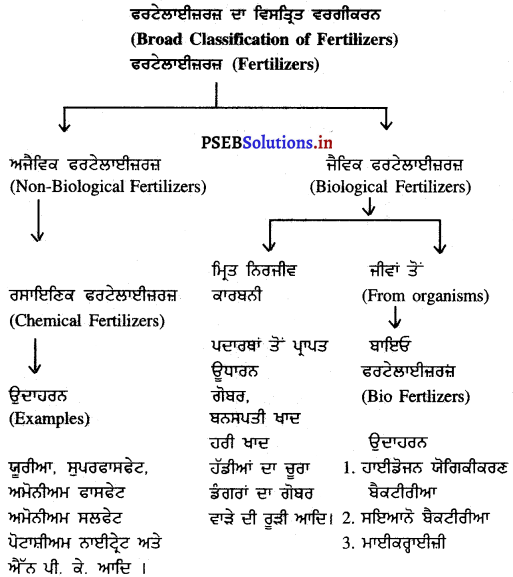
![]()
ਪ੍ਰਸ਼ਨ 2.
ਕਣਕ ਅਤੇ ਚੌਲਾਂ ਦੀਆਂ ਬੀਮਾਰੀਆਂ, ਰੋਗਨਕਾਂ ਦੇ ਨਾਮ ਅਤੇ ਕੰਟਰੋਲ ਕਰਨ ਦੇ ਤਰੀਕਿਆਂ ਬਾਰੇ ਦੱਸੋ ।
ਉੱਤਰ-
I. ਕਣਕ ਦੀਆਂ ਬੀਮਾਰੀਆਂ (Diseases of Wheat)-
(ਉ) ਕਣਕ ਦਾ ਕੁੰਗੀ ਰੋਗ (Rust of Wheat) ਚਿੱਤਰ 12.2
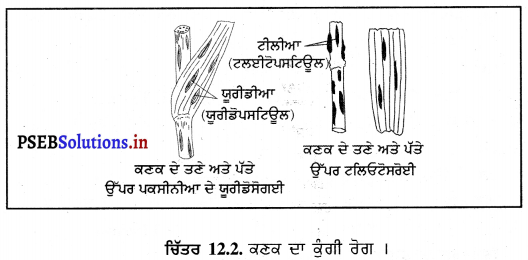
ਰੋਗਜਨਕ ਦਾ ਨਾਮ (Name of Pathogen) – ਪਸੀਨੀਆ ਮਿਨਿਸ ਗ੍ਰਿਟੀਸਾਈ (Puccinia Gramministritici)
ਰੋਗ ਦੇ ਚਿੰਨ੍ਹ (Symptoms of the disease)-
ਪੱਤਾ ਸ਼ੀਥ (Leaf sheath) ਉੱਪਰ ਭੂਰੀ, ਕਾਲੀ ਜਾਂ ਪੀਲੀ ਰੰਗਤ ਦੀਆਂ ਧਾਰੀਆਂ । (ਚਿੱਤਰ 12.2)
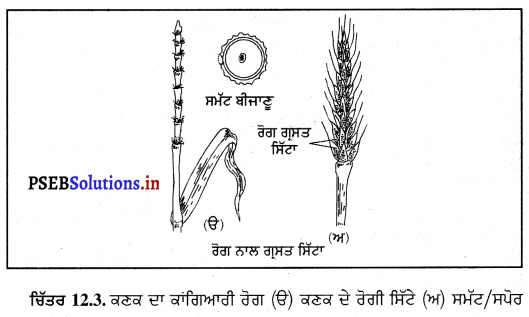
ਨਿਯੰਤਰਣ ਦੇ ਉਪਾਅ (Control Measures) – ਰੋਗ ਦਾ ਟਾਕਰਾ ਕਰ ਸਕਣ ਵਾਲੀਆਂ ਕਿਸਮਾਂ ਦੀ ਕਾਸ਼ਤ, ਅਗੇਤੀ ਬਿਜਾਈ, ਡਾਇਆ ਜੇਨ M-45 ਦਾ 2g ਵਾਲੇ ਘੋਲ ਦਾ ਛਿੜਕਾਅ (10-15 ਦਿਨਾਂ ਦੇ ਵਕਫੇ ਦੇ ਬਾਅਦ ।
ਨਿਯੰਤਰਣ ਦੇ ਉਪਾਅ
(i) ਬੀਮਾਰੀਆਂ ਦਾ ਟਾਕਰਾ ਕਰਨ ਵਾਲੀਆਂ ਜਾਤੀਆਂ ਦੀ ਬੀਜਾਈ ਕਰਨਾ ।
(ii) ਪ੍ਰਮਾਣਿਤ ਸਮੇਂ ਤੋਂ ਹਟ ਕੇ ਬੀਜਾਈ ਕਰਨਾ ਭਾਵ ਦੇਰ ਨਾਲ ਬੀਜਾਈ ਕਰਨਾ ।
(iii) ਰਸਾਇਣਿਕ ਖਾਦਾਂ ਦੀ ਘੱਟ ਵਰਤੋਂ ਕਰਨਾ ।
(iv) ਉੱਲੀਨਾਸ਼ਕਾਂ ਦੀ ਵਰਤੋਂ ਕਰਨਾ ਆਦਿ ।
(ਅ) ਕਣਕ ਦੀ ਕਾਂਗਿਆਰੀ (Smut of Wheat) (ਚਿੱਤਰ 12.3)
ਰੋਗਜਨਕ ਦਾ ਨਾਮ (Name of the Pathogen) : ਅਸਟੀਲੈਗੋ ਟੀਸਾਈ (ustilago tritici)
ਰੋਗ ਦੇ ਚਿੰਨ੍ਹ (Symptoms of the disease)-
ਬੀਜ ਦਾਨੀ ਵਿਚ ਦਾਣਿਆਂ ਦੀ ਥਾਂ ਧੁਆਂਖ ਦੇ ਰੰਗ ਵਰਗੇ ਬੀਜਾਣੂ ਸਮੂਹ (Spore mass) । ਬੀਜਾਣੂਆਂ ਦੇ ਖਿੰਡਣ ਉਪਰੰਤ ਨੰਗੀ ਰੇਕਸ (Naked Rachis)
ਨਿਯੰਤਰਣ ਦੇ ਉਪਾਅ (Control measures)-
- ਅਗੇਤੀ ਕਾਸ਼ਤ ।
- ਰੋਗਾਂ ਦਾ ਟਾਕਰਾ ਕਰ ਸਕਣ ਵਾਲੀਆਂ ਕਿਸਮਾਂ ਦੀ ਕਾਸ਼ਤ ।
- ਸਮੇਂ-ਸਮੇਂ ਸਿਰ ਉੱਲੀਨਾਸ਼ਕਾਂ ਦਾ ਛਿੜਕਾਅ ।
- ਸਖ਼ਤ ਗਰਮੀ ਦੇ ਦਿਨਾਂ ਵਿਚ ਬੀਜ ਦੀ ਸੋਧ ।
II. ਚੌਲਾਂ ਦੀਆਂ ਬੀਮਾਰੀਆਂ (Diseases of Rice)-
(ਉ) ਚੌਲਾਂ (ਝੋਨੇ) ਦਾ ਬਲਾਸਟ ਰੋਗ (Blast of Rice)
ਰੋਗ ਦੇ ਚਿੰਨ੍ਹ (Symptoms of the disease) – ਪੱਤਾ ਗਿਲਾਫ਼ (Leaf Sheath) ਅਤੇ ਪੱਤਿਆਂ ਉੱਪਰ ਬੇੜੀ ਦੀ ਸ਼ਕਲ ਦੇ ਭੁਰੀ ਰੰਗਤ ਵਾਲੇ ਜ਼ਖ਼ਮ ਪੈਦਾ ਹੋ ਜਾਂਦੇ ਹਨ। ਪੱਤੇ ਝੁਲਸੇ ਹੋਏ ਜਾਪਦੇ ਹਨ ।
ਰੋਗਜਨਕ ਦਾ ਨਾਮ (Name of the Pathogen) – ਪਾਇਰੀਕੂਲੇਰੀਆ ਓਰਾਇਜ਼ੀ (Pyricularia Oryzae)
ਕੰਟਰੋਲ ਦੇ ਉਪਾਅ (Control measures) :
- ਬੀਜਣ ਤੋਂ ਪਹਿਲਾਂ ਬੀਜਾਂ ਦੀ ਸੁਧਾਈ ਕਰਨ ਦੇ ਲਈ ਥੀਰਮ (Thiram) ਨਾਮ ਦੇ ਰਸਾਇਣ ਦੀ 2g/1 ਦੇ ਹਿਸਾਬ ਨਾਲ ਵਰਤੋਂ ।
- ਹਰ 10-15 ਦਿਨਾਂ ਦੇ ਅੰਤਰ ਦੇ ਬਾਅਦ 2g/1 ਦੇ ਹਿਸਾਬ ਨਾਲ ਬਾਵੀਸਟਿਨ (Bavistin) ਦਾ ਛਿੜਕਾਅ ਕੀਤਾ ਜਾਵੇ ।
(ਅ) ਚੌਲਾਂ ‘ ਤੇ ਭੂਰੇ ਦਾਗ਼ (Brown Spot of Rice)-
ਰੋਗ ਦੇ ਚਿੰਨ੍ਹ (Symptoms of the disease) – ਪੱਤਿਆਂ ਉੱਪਰ ਭੂਰੀ ਰੰਗਤ ਵਾਲੇ ਨਿਸ਼ਾਨ ।
ਰੋਗਜਨਕ – ਇਕ ਪ੍ਰਕਾਰ ਦੀ ਉੱਲੀ । ਕੰਟਰੋਲ ਦੇ ਉਪਾਅ (Control measures) :
- ਬੀਜਾਂ ਨੂੰ 2g/1 ਦੇ ਹਿਸਾਬ ਨਾਲ ਥੀਰਮ ਦੁਆਰਾ ਸੋਧ ਬੀਜਣ ਤੋਂ ਪਹਿਲਾਂ)
- ਬਾਵੀਸਟਿਨ ਦਾ 2g/1 ਦੀ ਦਰ ਨਾਲ 10-12 ਦਿਨਾਂ ਬਾਅਦ ਛਿੜਕਾਅ ਕੀਤਾ ਜਾਵੇ ।
ਪ੍ਰਸ਼ਨ 3.
ਕਪਾਹ (Cotton), ਗੰਨੇ (Sugarcane) ਅਤੇ ਆਲੂ (Potato) ਦੀਆਂ ਬੀਮਾਰੀਆਂ ਪੈਦਾ ਕਰਨ ਵਾਲੇ ਰੋਗਨਨਕਾਂ ਦੇ ਨਾਮ ਅਤੇ ਰੋਗਾਂ ਦੇ ਕੰਟਰੋਲ ਦੇ ਉਪਾਵਾਂ ਬਾਰੇ ਵਰਣਨ ਕਰੋ ।
ਉੱਤਰ-
1. ਕਪਾਹ ਦੀਆਂ ਬੀਮਾਰੀਆਂ (Diseases of Cotton)-
ਕਪਾਹ ਦਾ ਜੜ੍ਹ ਰੋਗ (Cotton root disease) :
ਰੋਗਜਨਕ (Pathogen) – ਮਿੱਟੀ ਵਿਚ ਮੌਜੂਦ ਉੱਲੀ ।
ਚਿੰਨ੍ਹ (Symptoms) – ਬਗੈਰ ਕਿਸੇ ਰੰਗ ਦੀ ਤਬਦੀਲੀ ਦੇ ਪੌਦੇ ਦੇ ਉੱਪਰਲੇ ਹਿੱਸੇ ਵਾਲੇ ਪੱਤਿਆਂ ਦਾ ਮੁਰਝਾਉਣਾ ।

ਕੰਟਰੋਲ ਦੇ ਉਪਾਅ (Control measures)
- 3-4 ਸਾਲਾਂ ਦੇ ਲਈ ਫ਼ਸਲਾਂ ਦੀ ਅਦਲਾ-ਬਦਲੀ (Crop Rotation) ।
- 5kg ਦਰ ਦੇ ਹਿਸਾਬ ਨਾਲ ਬੀਜਾਂ ਦੀ ਸੋਧ ਕਰਨ ਦੇ ਵਾਸਤੇ ਬੈਸੀਕਲ (Brassicol) ਦੀ ਵਰਤੋਂ । ਬੈਸੀਕਲ ਨੂੰ ਤੋਂ ਵਿਚ ਵੀ ਪਾ ਕੇ ਮਿੱਟੀ ਵਿਚ ਰਲਾਇਆ ਜਾ ਸਕਦਾ ਹੈ ।
2. ਆਲਟਰਨੇਰੀਆ ਪੱਤਾ ਧੱਬਾ (Alternaria Leaf Spot)-
ਰੋਗਜਨਕ (Pathogen) – ਉੱਲੀ (Fungus)
ਚਿੰਨ੍ਹ (Symptoms) – ਬੀਮਾਰੀ ਦੇ ਕਾਰਨ ਪੱਤੇ, ਸਹਿ ਪੱਤਰ (Bracts) ਅਤੇ ਕਪਾਹ ਦੇ ਟੰਡੇ (Cotton Bolls) ਪ੍ਰਭਾਵਿਤ ਹੁੰਦੇ ਹਨ । ਰੋਗ ਸ਼ੁਰੂ ਹੋਣ ਦੀ ਆਰੰਭਿਕ ਅਵਸਥਾ ਵਿਚ, ਬਾਅਦ ਦੀ ਅਵਸਥਾ ਦੇ ਮੁਕਾਬਲੇ ਭਾਰੀ ਨੁਕਸਾਨ ਹੁੰਦਾ ਹੈ ।
ਕੰਟਰੋਲ ਦੇ ਉਪਾਅ (Control measures) – ਰੋਗ ਨੂੰ ਫੈਲਣ ਤੋਂ ਰੋਕਣ ਦੇ ਲਈ ਅਤੇ ਇਸ ਤੇ ਕੰਟਰੋਲ ਕਰਨ ਦੇ ਲਈ ਕਿਸੇ ਵੀ ਕਿਸਮ ਦੇ ਉੱਲੀ ਨਾਸ਼ਕ ਦੀ ਵਰਤੋਂ ਕੀਤੀ ਜਾ ਸਕਦੀ ਹੈ ।
ਦੰਡਾਵਿ ਗਲ-ਸੜਨ (Boll Rot)-
ਰੋਗਜਨਕ (Pathogen) – ਉੱਲੀ ਅਤੇ ਜੀਵਾਣੁ ਦੋਵੇਂ ਹੀ ।
ਚਿੰਨ੍ਹ (Symptoms) – ਰੋਗ ਦੇ ਕਾਰਨ ਟੀਡੇ ਗਲ-ਸੜ ਜਾਂਦੇ ਹਨ ਜਿਸ ਦੇ ਕਾਰਨ ਬੀਜਾਂ ਅਤੇ ਰੇਸ਼ਿਆਂ ਦੀ ਗੁਣਵੱਤਾ ਘੱਟ ਜਾਂਦੀ ਹੈ ।
ਕੰਟਰੋਲ ਦੇ ਉਪਾਅ (Control measures) – ਟਾਂਡਿਆਂ (Bolls) ਦੇ ਬਣਨ ਸਮੇਂ ਪੌਦਿਆਂ ਉੱਤੇ ਕਾਪਰ ਆਕਸੀਕਲੋਰਾਈਡ (Copper oxychloride) ਦਾ ਛਿੜਕਾਓ ਕਰਨਾ ।
3. ਗੰਨੇ ਦੀਆਂ ਬੀਮਾਰੀਆਂ (Diseases of Sugar cane)
ਗੰਨੇ ਦਾ ਲਾਲ ਧਾਰੀ ਸੜਣ ਰੋਗ (Red rot of Sugar Cane)-
ਰੋਗਜਨਕ (Pathogen) – ਇਹ ਉੱਲੀ ਰੋਗ (Fungal disease) ਹੈ ।
ਉੱਲੀ ਦਾ ਨਾਂ Colletotricam falcatus
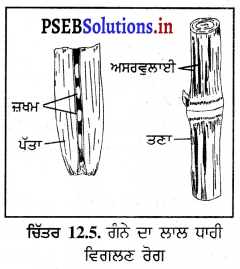
ਅਸਰਵੁਲਾਈ ਚਿੰਨ੍ਹ (Symptoms) – ਆਰੰਭ ਵਿਚ ਪੱਤਿਆਂ ਦੀ ਮੱਧ ਸ਼ਿਰਾ (Midrib) ਉੱਤੇ ਛੋਟੇ ਆਕਾਰ
ਤਣਾਵਾਲੇ ਲਾਲ ਧੱਬੇ ਪੈਦਾ ਹੁੰਦੇ ਹਨ, ਗੰਨੇ ਦੀਆਂ ਪੋਰੀਆਂ ਵਿਚਲਾ ਗੁੱਦੇ (Peth) ਦਾ ਰੰਗ ਲਾਲ ਹੋ ਜਾਂਦਾ ਹੈ ਅਤੇ ਪੋਰੀਆਂ ਦੀ ਸਤ੍ਹਾ ਤੇ ਲਾਲ ਰੰਗ ਦੇ ਚੀਰ ਪੈਦਾ ਹੋ ਜਾਂਦੇ ਹਨ । ਗੰਨੇ ਦੇ ਰਸ ਚਿੱਤਰ ਵਿਚੋਂ ਦੁਰਗੰਧ ਵੀ ਆਉਣ ਲਗਦੀ ਹੈ ।
ਕੰਟਰੋਲ ਦੇ ਉਪਾਅ (Control measures)-
- ਫ਼ਸਲੀ ਚੱਕਰ ਜਾਂ ਫ਼ਸਲਾਂ ਦੀ ਬਦਲ-ਬਦਲ ਕੇ ਕਾਸ਼ਤ
- ਪ੍ਰਭਾਵਿਤ ਗੰਨਿਆਂ ਦੀ ਰਹਿੰਦ-ਖੂੰਹਦ ਦਾ ਨਿਪਟਾਰਾ ।
- ਬੀਜ ਵਜੋਂ ਵਰਤੇ ਜਾਣ ਵਾਲੇ ਗੰਨੇ ਦੇ ਟੁਕੜਿਆਂ ਨੂੰ 0.25% ਐਗਾਲੋਲ ਘੋਲ (Agallal Solution) ਵਿਚ ਡੁਬਾਉਣਾ, ਬੀਜਣ ਤੋਂ ਪਹਿਲਾਂ ਇਨ੍ਹਾਂ ਪੋਰੀਆਂ ਨੂੰ 5 ਮਿੰਟਾਂ ਦੇ ਲਈ ਘੋਲ ਵਿਚ ਡੁੱਬੇ ਰਹਿਣ ਦਿਓ ।
4. ਆਲੂ ਦਾ ਪਛੇਤਾ ਝੁਲਸ ਰੋਗ (Late Blight of Potato)-
ਰੋਗਜਨਕ (Pathogen) – ਫਾਈਟੋਪਥੋਰਾ ਇੰਟੈਂਸਟੈਂਸ (Phytophthora infestans) – ਇਹ ਉੱਲੀ ਰੋਗ (Fungal disease) ਹੈ ।

ਚਿੰਨ੍ਹ (Symptoms)-
- ਬੀਮਾਰੀ ਦੇ ਆਰੰਭ ਵਿਚ ਪੱਤਿਆਂ ਦੇ ਸਿਰਿਆਂ ‘ਤੇ ਜ਼ਖ਼ਮ ਬਣਨ ਲਗਦੇ ਹਨ ਜਿਹੜੇ ਬਾਅਦ ਵਿਚ ਟਿਸ਼ੂ ਖਈ (Necrotic) ਬਣ ਜਾਂਦੇ ਹਨ ।
- ਟਿਸ਼-ਖਈ ਵਾਲੇ ਖੇਤਰਾਂ ਦੀ ਰੰਗਤ ਭਰੀ ਤੋਂ ਕਾਲੀ ਵਿਚ ਬਦਲ ਜਾਂਦੀ ਹੈ ।
- ਸਿੱਲ੍ਹੇ ਮੌਸਮ ਵਿਚ ਸਾਰੇ ਦਾ ਸਾਰਾ ਪੱਤਾ ਰੋਗ ਗ੍ਰਸਤ ਹੋ ਜਾਂਦਾ ਹੈ ।
- ਕੁੱਝ ਸਮੇਂ ਬਾਅਦ ਜ਼ਮੀਨ ਹੇਠਲਾ ਆਲੂ ਵੀ ਰੋਗ ਨਾਲ ਪੀੜਤ ਹੋ ਜਾਂਦਾ ਹੈ ਅਤੇ ਗਲਣ ਲੱਗ ਪੈਂਦਾ ਹੈ ।
ਕੰਟਰੋਲ ਦੇ ਉਪਾਅ (Control Measures)-
- ਬੀਮਾਰੀ ਦਾ ਟਾਕਰਾ ਕਰਨ ਵਾਲੀਆਂ ਕਿਸਮਾਂ ਦੀ ਕਾਸ਼ਤ ਕੀਤੀ ਜਾਵੇ ।
- 15 ਦਿਨਾਂ ਦੇ ਅੰਤਰਕਾਲ ਦੇ ਬਾਅਦ ਫ਼ਸਲਾਂ ‘ਤੇ ਬਾਵੇਸਟਿਨ (Bavesten) ਨਾਮ ਦੀ ਦਵਾਈ ਦੇ 0.05% ਘੋਲ ਦਾ ਛਿੜਕਾਓ ਕਰਨਾ ।
- ਫ਼ਸਲੀ ਚੱਕਰ (Crop Rotation)
ਪ੍ਰਸ਼ਨ 4.
ਜੈਵਿਕ-ਖਾਦ ਦੇ ਕਿਸੇ ਪੰਜ ਲਾਤਾਂ ਦਾ ਵਰਣਨ ਕਰੋ ।
ਉੱਤਰ-
ਜੈਵਿਕ-ਖਾਦ (Bio-Fertilizers) – ਜਿਹੜੇ ਖਾਦ ਸਜੀਵਾਂ ਤੋਂ ਪ੍ਰਾਪਤ ਹੋਣ, ਉਨ੍ਹਾਂ ਨੂੰ ਜੈਵਿਕ-ਖਾਦ ਆਖਦੇ ਹਨ ।
ਲਾਭ (Advantages)-
(i) ਜਿਹੜੇ ਬੈਕਟੀਰੀਆ ਜੈਵਿਕ ਖਾਦਾਂ ਵਜੋਂ ਕਾਰਜ ਕਰਦੇ ਹਨ ਉਨ੍ਹਾਂ ਵਿਚੋਂ ਰਾਈਜ਼ੋਬੀਅਮ (Rhizobium) ਨਾਂ ਵਾਲਾ ਬੈਕਟੀਰੀਆ ਪਮੁੱਖ ਹੈ । ਫਲੀਦਾਰ ਪੌਦਿਆਂ ਦੀਆਂ ਜੜ੍ਹਾਂ ‘ਤੇ ਪਾਈਆਂ ਜਾਂਦੀਆਂ ਜੜ੍ਹਾਂ ਤੇ ਮੌਜੂਦ ਗੰਢਾਂ (Nodules) ਅੰਦਰ ਇਹ ਬੈਕਟੀਰੀਆ ਰਹਿੰਦਿਆਂ ਹੋਇਆਂ ਵਾਤਾਵਰਣੀ ਨਾਈਟ੍ਰੋਜਨ ਨੂੰ ਨਾਈਟ੍ਰੇਟ ਵਿੱਚ ਸਥਿਰੀਕਰਨ ਕਰਦੇ ਹਨ ਅਤੇ ਇਹ ਨਾਈਟ੍ਰੇਟ ਮਿੱਟੀ ਅੰਦਰ ਮਿਲ ਕੇ ਮਿੱਟੀ ਦੀ ਉਪਜਾਊ ਸ਼ਕਤੀ ਵਿਚ ਵਾਧਾ ਕਰਦੇ ਹਨ ।
(ii) ਅਜੋਟੋ ਬੈਕਟਰ (Azotobacter) ਨਾਂ ਦਾ ਬੈਕਟੀਰੀਆ ਨਾਈਟ੍ਰੋਫਾਸ ਖਾਦਾਂ ਨਾਲ ਮਿਲ ਕੇ ਕੰਮ ਕਰਨ ਉਪਰੰਤ ਫ਼ਸਲਾਂ ਦੇ ਝਾੜ ਵਿਚ 15-35% ਦਾ ਵਾਧਾ ਹੋ ਜਾਂਦਾ ਹੈ ਅਤੇ ਇਹ ਵਾਧਾ ਸਬਜ਼ੀਆਂ ਵਿਚ ਆਮ ਹੈ ।
(iii) ਸੰਜੀਵੀ ਸਾਇਨੋਬੈਕਟੀਰੀਆ (Symbiotic Cyanobacteria) – ਇਨ੍ਹਾਂ ਬੈਕਟੀਰੀਆ . ਨੂੰ ਨੀਲੀ-ਹਰੀ ਐਲਗੀ ਵੀ ਆਖਦੇ ਹਨ । ਨਾਈਟ੍ਰੋਜਨ ਨੂੰ ਸਥਿਰੀਕਰਨ ਵਿਚ ਐਨਾਬੀਨਾ (Anabaena) ਨਾਂ ਦਾ ਨੀਲਾ-ਹਰਾ ਐਲਗਾ ਵਿਸ਼ੇਸ਼ ਹੈਂ । ਨਾਈਟ੍ਰੋਜਨ ਦਾ ਸਥਿਰੀਕਰਨ ਤੋਂ ਪਹਿਲਾਂ ਇਹ ਬੈਕਟੀਰੀਆ ਆਕਸਿਨ (Auxin), ਐਨਕਾਰਬਿਕ ਤੇਜ਼ਾਬ ਅਤੇ ਵਿਟਾਮਿਨ B ਪੈਦਾ ਕਰਦਾ ਹੈ ਅਤੇ ਇਹ ਹਾਰਮੋਨਜ਼ ਫ਼ਸਲਾਂ ਦੇ ਵਾਧੇ ਵਿਚ ਅਤੇ ਝੜ ਦੇ ਵਧਣ ਲਈ ਵਿਸ਼ੇਸ਼ ਭੂਮਿਕਾ ਨਿਭਾਉਂਦੇ ਹਨ । ਅਜ਼ੋਲਾ (Azolla) ਨਾਂ ਦਾ ਜਲ-ਜਲੀ ਪੌਦਾ ਵੀ ਨਾਈਟ੍ਰੋਜਨ ਦਾ ਸਥਿਰੀਕਰਨ ਕਰਦਿਆਂ ਹੋਇਆਂ ਪਾਣੀ ਅੰਦਰ ਉੱਗਣ ਵਾਲੀ ਬਨਸਪਤੀ ਦੇ ਵਾਧੇ ਅਤੇ ਵਿਕਾਸ ਲਈ ਜੁੰਮੇਵਾਰ ਹੈ । ਇਸ ਦੀਆਂ ਜੜਾਂ ਵਿਚ ਐਨਾਬੀਨਾ ਹੁੰਦਾ ਹੈ ।
(iv) ਮਾਈਕੋਰਾਈਜ਼ੀ (Mycorrhizae) ਫੰਜਾਈ ਦੇ ਹਾਇਫਿਆ (Hyphae) ਅਤੇ ਉੱਚਕੋਟੀ ਦੇ ਪੌਦਿਆਂ ਦੀਆਂ ਜੜ੍ਹਾਂ ਵਿਚਾਲੇ ਦੇ ਇਸ ਸੰਬੰਧ ਨੂੰ ਸਹਿਜੀਵਨ (Synbiosis) ਆਖਦੇ ਹਨ । ਉੱਲੀ ਦੇ ਹਾਈਕੇ ਜ਼ਮੀਨ ਤੋਂ ਪਾਣੀ ਤੇ ਖਣਿਜ ਸੋਖ ਕੇ ਰੁੱਖ ਦੀਆਂ ਜੜ੍ਹਾਂ ਨੂੰ ਸਪਲਾਈ ਕਰਦੇ ਹਨ ਅਤੇ ਇਸ ਤਰ੍ਹਾਂ ਜੜ੍ਹ ਰੋਗਾਂ (Root hairs) ਦੀ ਘਾਟ ਨੂੰ ਪੂਰਿਆਂ ਕਰਦੇ ਹਨ । ਉੱਚ-ਕੋਟੀ ਦੇ ਪੌਦਿਆਂ ਨੂੰ ਉੱਲੀ ਨੂੰ ਭੋਜਨ ਪ੍ਰਾਪਤ ਹੋਣ ਦੇ ਇਲਾਵਾ ਨਿਕਾਸ ਵੀ ਉਪਲੱਬਧ ਹੁੰਦਾ ਹੈ ।
(v) ਜੈਵਿਕ ਖਾਦਾਂ ਵਾਤਾਵਰਣ ਨੂੰ ਪ੍ਰਦੂਸ਼ਿਤ ਨਹੀਂ ਕਰਦੀਆਂ ।
(vi) ਜੈਵਿਕ ਖਾਦਾਂ ਜੀਵਨਰੋਧੀ (Antibiotic) ਵੀ ਹਨ ਅਤੇ ਇਹ ਹਾਨੀਕਾਰਕ ਜੀਵਾਂ ਨੂੰ ਨਸ਼ਟ ਵੀ ਕਰਦੀਆਂ ਹਨ ।
(vii) ਜੈਵਿਕ ਖਾਦਾਂ ਤੋਂ ਦੇ ਭੌਤਿਕ ਅਤੇ ਰਸਾਇਣਿਕ ਗੁਣਾਂ ਵਿਚ ਤਬਦੀਲੀ ਕਰ ਸਕਦੀਆਂ ਹਨ ਅਤੇ ਇਨ੍ਹਾਂ ਤਬਦੀਲੀਆਂ ਦੇ ਕਾਰਨ ਮਿੱਟੀ ਦੀ ਪਾਣੀ ਨੂੰ ਜਕੜਨ ਦੀ ਸ਼ਕਤੀ ਵਿਚ ਵਾਧਾ ਹੋ ਜਾਂਦਾ ਹੈ ।
![]()
ਪ੍ਰਸ਼ਨ 5.
ਭਾਰਤ ਵਿਚ ਜੈਵਿਕ ਪੈਸਟ ਕੰਟਰੋਲ ਦੇ ਆਮ ਤਰੀਕੇ ਕਿਹੜੇ ਹਨ ?
ਉੱਤਰ-
ਭਾਰਤ ਵਿੱਚ ਵਾਤਾਵਰਣ ਸ਼ੁੱਧ ਰੱਖਣ ਦੇ ਮੰਤਵ ਲਈ ਪੈਸਟਾਂ ਉੱਤੇ ਕੰਟਰੋਲ ਕਰਨ ਦੇ ਕਈ ਤਰ੍ਹਾਂ ਦੇ ਤਰੀਕੇ ਵਰਤੇ ਜਾਂਦੇ ਹਨ-ਉਨ੍ਹਾਂ ਵਿਚੋਂ ਕੁਝ ਕੁ ਦਾ ਵੇਰਵਾ ਹੇਠਾਂ ਦਿੱਤਾ ਗਿਆ ਹੈ-
I. ਰੋਗਜਨਕ (Pathogens), ਪਰਜੀਵੀ (Parasites) ਅਤੇ ਸ਼ਿਕਾਰੀ (Predators) ਰੋਗਜਨਕਾਂ, ਪਰਜੀਵੀਆਂ ਅਤੇ ਸ਼ਿਕਾਰੀਆਂ ਨੂੰ ਨਸ਼ਟ ਕਰਨ ਦੇ ਲਈ ਉਨ੍ਹਾਂ ਦੇ ਕੁਦਰਤੀ ਪਰਜੀਵੀਆਂ ਅਤੇ ਸ਼ਿਕਾਰੀਆਂ ਦੀ ਵਰਤੋਂ ਕੀਤੀ ਜਾਣੀ ਹੈ । ਇਨ੍ਹਾਂ ਨਾਸ਼ਕਾਂ ਦੇ ਕੁੱਝ ਉਦਾਹਰਨ ਹੇਠਾਂ ਦਿੱਤੇ ਜਾਂਦੇ ਹਨ-
(1) ਬੈਕੁਲੋਵਾਇਰਸਿਜ਼ (Baculoviruses) – ਵਾਇਰਸਿਜ਼ ਦਾ ਇਹ ਇਕ ਅਜਿਹਾ ਗਰੁੱਪ ਹੈ ਜਿਸ ਦੀ ਵਰਤੋਂ ਕੀੜੀਆਂ (Ants), ਭਿੰਡਾਂ (Wasps) ਅਤੇ ਬੀਟਲਜ਼ ਨੂੰ ਇਹਨਾਂ ਦੀ ਲਾਰਵਾ ਅਵਸਥਾ (arval stage) ਤੇ ਨਸ਼ਟ ਕਰਨ ਲਈ ਕੀਤੀ ਜਾਂਦੀ ਹੈ । ਇਹ ਵਾਇਰਸਿਜ਼ ਉਪਰੋਕਤ ਵਿਨਾਸ਼ਕਾਰੀਆਂ ਨੂੰ ਨਸ਼ਟ ਕਰਨ ਦੇ ਲਈ ਕਾਰਆਮਦ ਹਨ ਸਗੋਂ ਇਨ੍ਹਾਂ ਦੀ ਵਰਤੋਂ ਕਰਨ ਨਾਲ ਹੋਰ ਕਿਸੇ ਵੀ ਪ੍ਰਕਾਰ ਦੇ ਸਜੀਵਾਂ ਨੂੰ ਕੋਈ ਨੁਕਸਾਨ ਨਹੀਂ ਪਹੁੰਚਦਾ ।
(2) ਭੰਬਣ (Moths), ਮੱਖੀਆਂ (Flies), ਬੀਟਲਜ਼ (Beetles) ਅਤੇ ਮੱਛਰਾਂ ਨੂੰ ਨਸ਼ਟ ਕਰਨ ਦੇ ਵਾਸਤੇ ਬੈਸੀਲਸ ਬੂਰੈਨਜੀਐਨਸਿਸ (Bacillus thuringiensis) ਜਿਸਦਾ ਸੰਖੇਪ BT ਹੈ , ਦੀ ਵਰਤੋਂ ਕੀਤੀ ਜਾਂਦੀ ਹੈ । ਇਸ ਕੀਟਾਣੂ ਦੀਆਂ ਕੁਝ ਕਿਸਮਾਂ ਵਿਚ ਪਾਣੀਆਂ ਅਤੇ ਪੌਦਿਆਂ ਦੇ ਪਰਜੀਵੀਆਂ ਨੂੰ ਨਸ਼ਟ ਕਰਨ ਦੀ ਸ਼ਕਤੀ ਵੀ ਹੈ । ਇਨ੍ਹਾਂ ਹਾਨੀਕਾਰਕ ਜੀਵਾਂ ਵਿੱਚ ਨੈਮਾਟੋਡਜ਼ (Nemotodes), ਸਨੇਲਜ਼ (Snails), ਪ੍ਰੋਟੇਚੂਓਨਜ਼ (Protozoans) ਅਤੇ ਤਲਛੱਟੇ (Cockroaches) ਸ਼ਾਮਿਲ ਹਨ ।
ਤੇਲੇ (Aphids) ਨੂੰ ਕੰਟਰੋਲ ਕਰਨ ਦੇ ਲਈ ਲੇਡੀ ਬੱਗ (Lady bug) ਜਾਂ ਇੰਗ ਮੈਟਿਸ (Preying Mantis) ਤੋਂ ਕੰਮ ਲਿਆ ਜਾਂਦਾ ਹੈ ।
II. ਬਾਂਝ ਜਾਂ ਬੇ-ਪੈਦ ਕਰਨ ਦੀ ਵਿਧੀ (Sterilisation strategy) – ਲਰ ਕੀਟਾਂ ਨੂੰ ਬਾਂਝ ਕਰਨ ਜਾਂ ਬੇ-ਪੈਦ ਕਰਨ ਦੇ ਵਾਸਤੇ ਕਿਰਣਨ/ਰੇਡੀਏਸ਼ਨ (Irridiation) ਦਾ ਤਰੀਕਾ ਅਪਣਾਇਆ ਜਾਂਦਾ ਹੈ । ਇਨ੍ਹਾਂ ਨਰ ਕੀਟਾਂ ਨੂੰ ਪ੍ਰਯੋਗਸ਼ਾਲਾ ਵਿਚ ਪਾਲ ਕੇ, ਕਿਰਣਨ ਕਰਨ ਉਪਰੰਤ ਪ੍ਰਜਣਨ ਦੇ ਸਮੇਂ ਛੱਡ ਦਿੱਤਾ ਜਾਂਦਾ ਹੈ | ਮਦੀਨ ਕੀਟ ਅਜਿਹੇ ਬੇ-ਪੈਦ ਨਰਾਂ ਨਾਲ ਸੰਭੋਗ ਤਾਂ ਕਰਦੇ ਹਨ ਪਰ ਉਹ ਨਸਲ (ਬੱਚੇ) ਪੈਦਾ ਕਰਨ ਦੇ ਸਮਰੱਥ ਨਹੀਂ ਹੁੰਦੇ ਅਤੇ ਇਸ ਤਰ੍ਹਾਂ ਹਾਨੀਕਾਰਕ ਕੀਟਾਂ ਦੀ ਸੰਖਿਆ ਤੇ ਕੰਟਰੋਲ ਕੀਤਾ ਜਾਂਦਾ ਹੈ ।
II. ਵੀਰੋਮੋਨਜ਼ (Pheromones) – ਇਹ ਉੱਚ-ਕੋਟੀ ਦੇ ਉੱਡਣਸ਼ੀਲ (Volatile) ਰਸਾਇਣ ਹਨ, ਜਿਹੜੇ ਕੀਟਾਂ ਨੂੰ ਇਕ-ਦੂਸਰੇ ਵਲ ਨਾ ਸਿਰਫ਼ ਆਕਰਸ਼ਿਤ ਹੀ ਕਰਦੇ ਹਨ, ਸਗੋਂ ਉਨ੍ਹਾਂ ਵਿਚਾਲੇ ਸੁਨੇਹੇ ਪਹੁੰਚਾਉਣ ਦਾ ਕੰਮ ਵੀ ਕਰਦੇ ਹਨ । ਇਹ ਰਸਾਇਣ ਮਦੀਨ ਕੀਟਾਂ ਦੁਆਰਾ ਪੈਦਾ ਕੀਤੇ ਜਾਂਦੇ ਹਨ ਅਤੇ ਨਰ ਕੀਟ ਇਨ੍ਹਾਂ ਰਸਾਇਣਾਂ ਦੀ ਸੂਹ (Detect) ਲਗਾ ਲੈਂਦੇ ਹਨ । ਇਹ ਰਸਾਇਣ ਜਾਤੀ ਵਿਸ਼ੇਸ਼ ਹਨ । ਬਨਾਉਟੀ ਫੀਰੋਮੋਨਜ਼ ਦੀ ਵਰਤੋਂ ਕਰਦਿਆਂ ਹੋਇਆਂ ਕੀਟਾਂ ਦੀ ਉਤਪੱਤੀ ਉੱਪਰ ਨਿਯੰਤਰਨ ਕੀਤਾ ਜਾ ਸਕਦਾ ਹੈ ।
IV. ਕੁਦਰਤੀ/ਕਿਰਤਿਕ ਕੀਟਨਾਸ਼ਕ (Natural Insecticides) – ਇਹ ਕੀਟਨਾਸ਼ਕ ਜੈਵਿਕ ਸਰੋਤਾਂ ਤੋਂ ਤਿਆਰ ਕੀਤੇ ਜਾਂਦੇ ਹਨ । ਇਹ ਕੀਟ ਨਾਸ਼ਕ ਪੌਦਿਆਂ ਅਤੇ ਅਕਸਰ ਸੂਖਮ ਜੀਵਾਂ ਤੋਂ ਪ੍ਰਾਪਤ ਕੀਤੇ ਜਾਂਦੇ ਹਨ । ਪੌਦਿਆਂ ਤੋਂ ਪ੍ਰਾਪਤ ਹੋਣ ਵਾਲੇ ਇਹ ਪਦਾਰਥ ਚਿਰਜੀਵੀ ਨਹੀਂ ਹੁੰਦੇ ਸਗੋਂ ਇਹ ਕੁਦਰਤੀ ਹਨ । ਇਹ ਘੱਟ ਵਿਸ਼ੈਲੇ ਹੋਣ ਕਾਰਨ ਥਣਧਾਰੀ ਪ੍ਰਾਣੀਆਂ ਨੂੰ ਕਿਸੇ ਪ੍ਰਕਾਰ ਦਾ ਨੁਕਸਾਨ ਨਹੀਂ ਪਹੁੰਚਾਉਂਦੇ । ਇਹ ਕੀਟਨਾਸ਼ਕ ਜੀਵ-ਵਿਘਟਨਸ਼ੀਲ ਹਨ । ਇਨ੍ਹਾਂ ਕੁਦਰਤੀ ਕੀਟਨਾਸ਼ਕਾਂ ਦੀ ਸੰਖਿਆ ਕਾਫ਼ੀ ਜ਼ਿਆਦਾ ਹੈ ।


